A contrasting appearance against the natural habitat is specific to most white birds.
From parrots to storks, white birds come in all shapes and sizes. Some are purely white while others also show colored plumage sections across their body or wings.
White birds may be migratory or sedentary. They are found on all continents, including Antarctica.
Coastal areas are known to attract a wide number of white birds such as gulls.
A long migration is also specific to many white birds. They can fly over continents and oceans to overwinter.
Furthermore, some white birds may also fly to the same breeding location every year.
It’s not uncommon for white birds to migrate in large flocks.
Migrating groups may fly in a V-shaped group or even individually.
Here are some of the most common types of white birds of the world with their most important unique characteristics.
Table of Contents
1. Great Egret
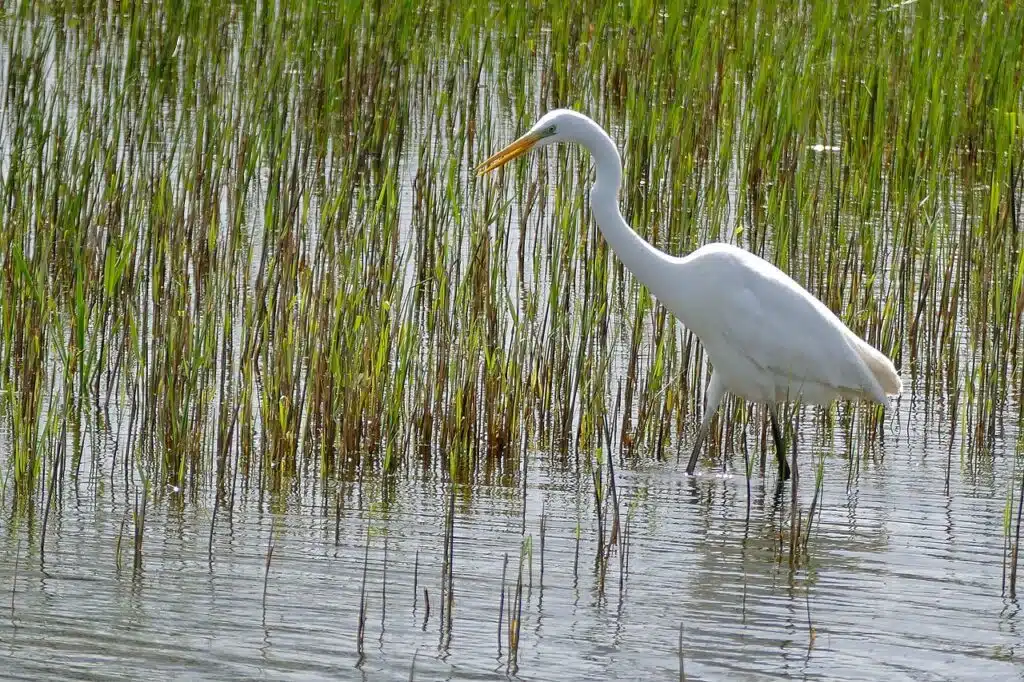
Great Egret (Ardea alba) have completely white plumage. These birds remain almost completely white throughout the year.
There are 4 Great Egret subspecies around the world. Some of these subspecies may show green skin around the eyes during their breeding season.
A species also known for its long yellow bill, Great Egrets are marked by their shallow water habitat in their feeding habits. Most of their foods include fish and frogs.
Different types of amphibians and even various types of snakes such as water-bound snakes are also eaten by the bird.
Distribution – Africa, South America, Europe, Asia, North America
Migratory – Yes
2. Snowy Egret
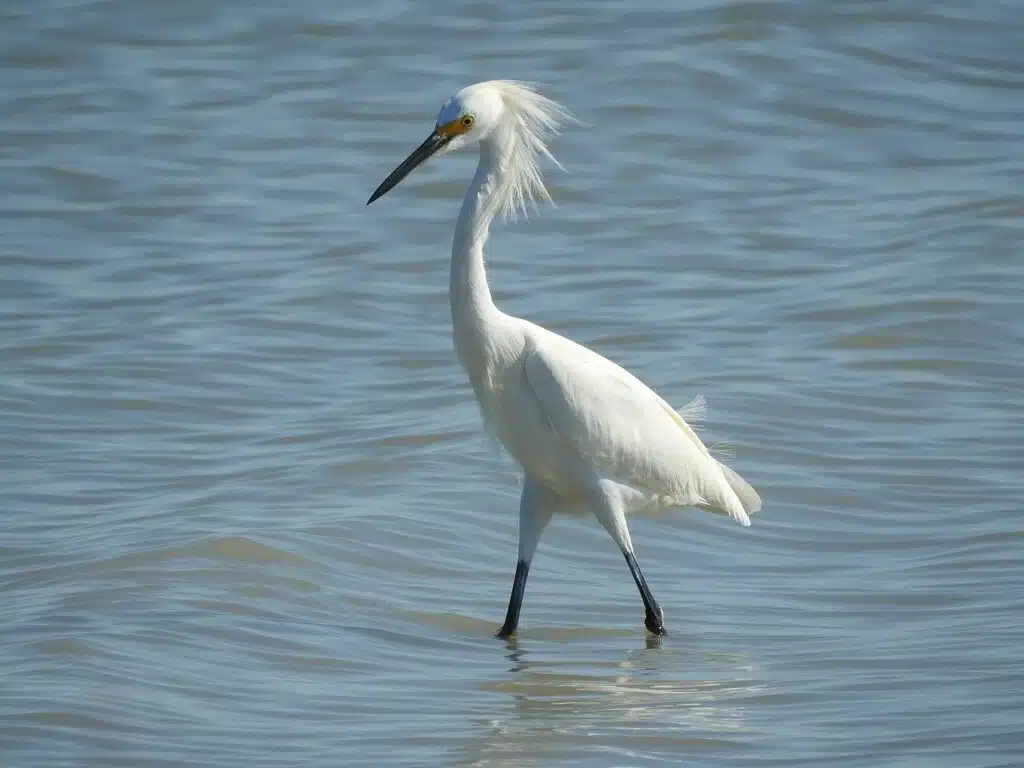
White plumage and a white crest are specific to The Snowy Egret (Egretta thula). A species that may reach a maximum size of 26 inches, also shows a contrasting yellow beak and thin long black, and yellow legs.
Much of the coloring of the species is impacted by age as the young Snowy Egrets have green legs.
Snails, frogs, snakes, reptiles, fish, and crabs are among the typical diet of the species which is often spotted in colonies with other birds living in shallow water.
Also found in the Southern US states, the bird may or may not migrate to warmer climes in Mexico and Central America.
Distribution – The Gulf of Mexico, Southwestern US, Central America, South America
Migratory – Yes
3. White Ibis
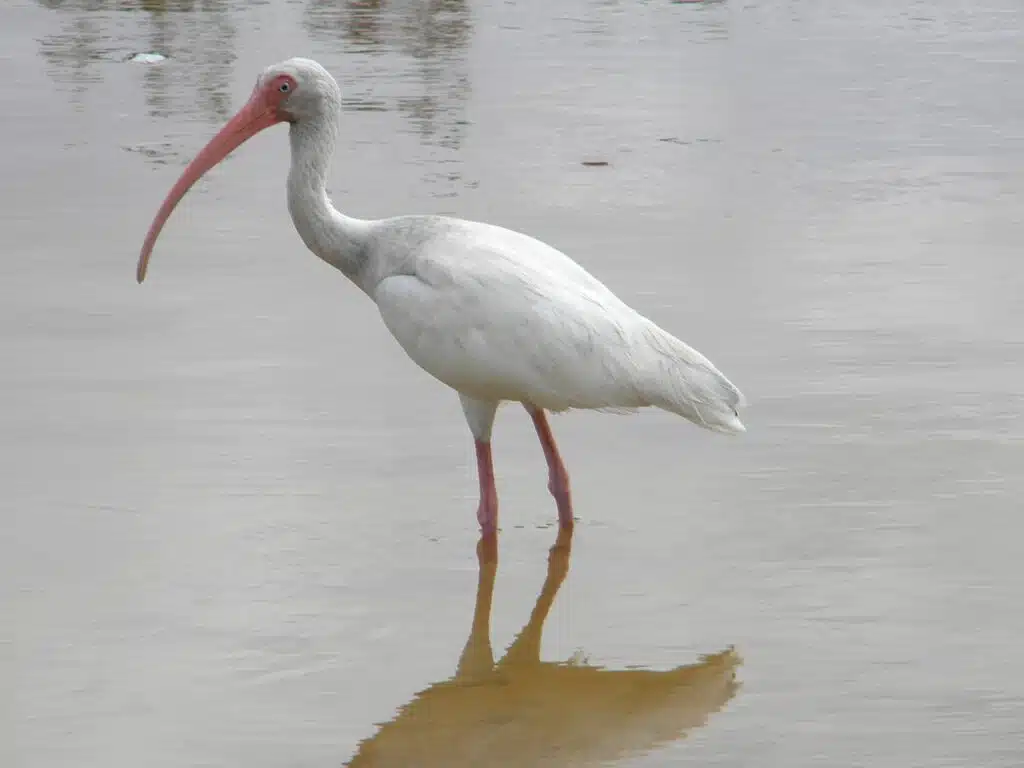
The White Ibis (Eudocimus albus) is named after its completely white plumage except for its wings’ tips.
Birds of the species have black wing tips which may not be easily visible when the bird is resting.
An orange-red beak is specific to these birds. While both males and females have a similarly-colored beak, it’s the males that have a longer beak.
Males are also slightly larger than females. The average adult White Ibis grows to a size between 21 and 28 inches.
This species might be seen flying in flocks in a V-shaped grouping.
Distribution – The Gulf of Mexico, Mexico, Cuba, Central America, Colombia, Venezuela
Migratory – Yes
4. American White Pelican
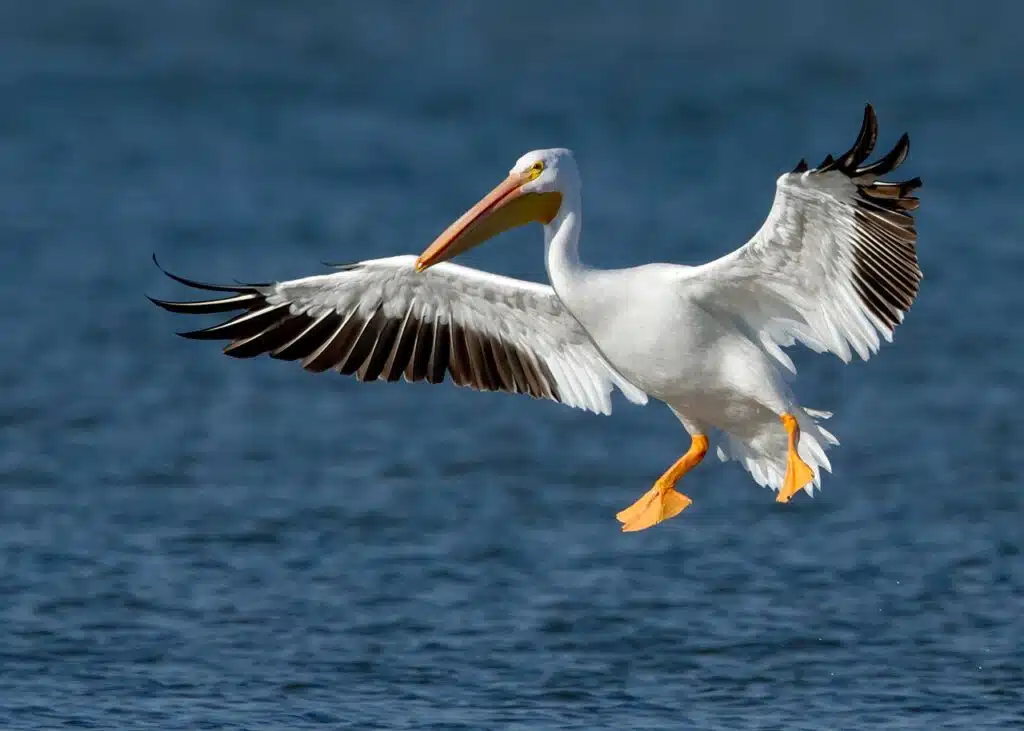
A mostly white appearance is characteristic of The American White Pelican (Pelecanus erythrorhynchos). This is a species that shows contrasting black remiges, which only represent a small part of their wings.
A white crest is also specific to these birds.
Birds of this family also show an orange bill and orange skin patches around the bill during the breeding season.
A species that never grows more than 14 inches, The American White Pelican is found across different states such as California and Florida.
These birds are known to live on water and eat different types of fish. They even eat invasive fish species such as carp.
Distribution – Canada, United States, The Gulf of Mexico
Migratory – Yes
5. Mute Swan
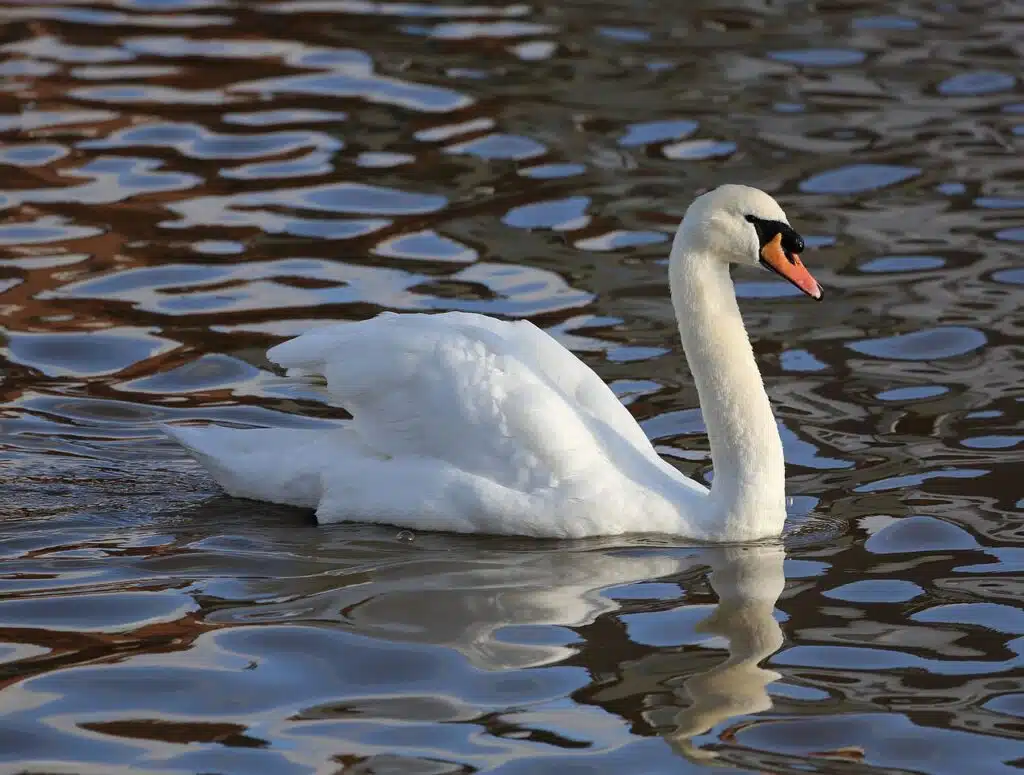
Mute Swans (Cygnus olor) are natives of Europe and Asia. They have been introduced and established in North America.
These swans grow to a size between 50 and 63 inches as they reach adulthood.
Pure white plumage is specific to these birds with a black face and an orange bill.
A protected species in most countries it lives in, The Mute Swan may also migrate to overwinter. This is a rare habit, however.
Much of its range in the United States are areas where Mute Swans may show an invasive species habit, driving out local waterfowls.
Distribution – Europe, North America, Japan
Migratory – Partially migratory
6. Cattle Egret
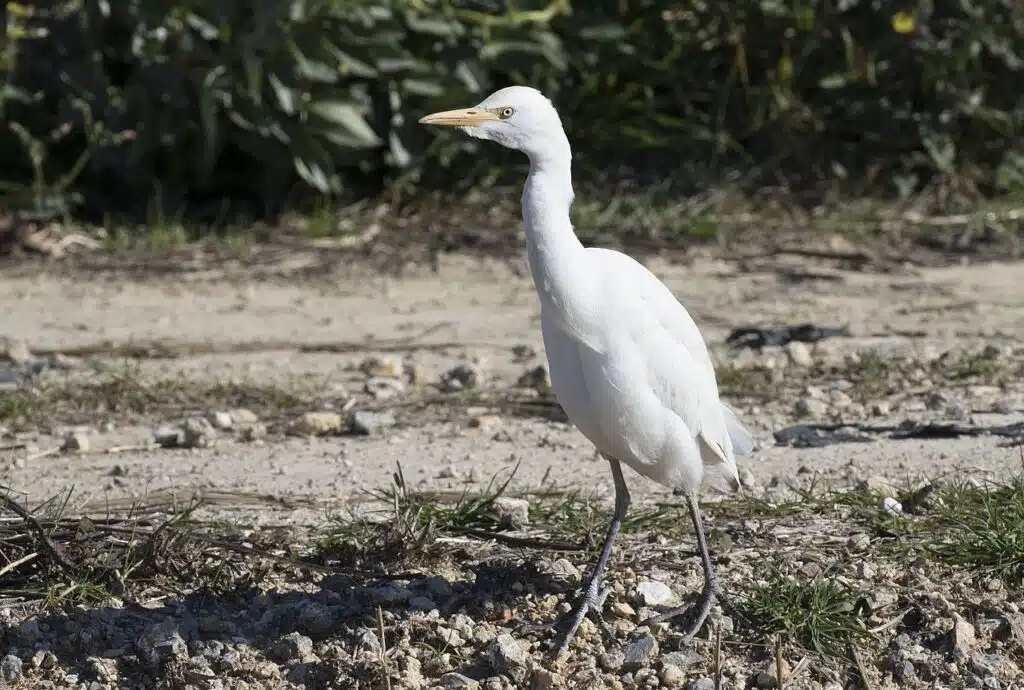
A mostly white color is characteristic of Cattle Egrets (Bubulcus ibis). This species shows orange buffs during the breeding season.
Originally not found across America, Cattle Egrets started to colonize parts of the world over a century ago.
Today, they are found on all continents, outside of their South American and African habitats where they are found throughout the year.
As its name implies, this is a species that colonizes open fields with cows as they follow insects around cows.
These birds also eat different bugs such as grasshoppers.
Distribution – South America, Africa, South Asia, Australia, North America
Migratory – Yes
7. Snow Goose
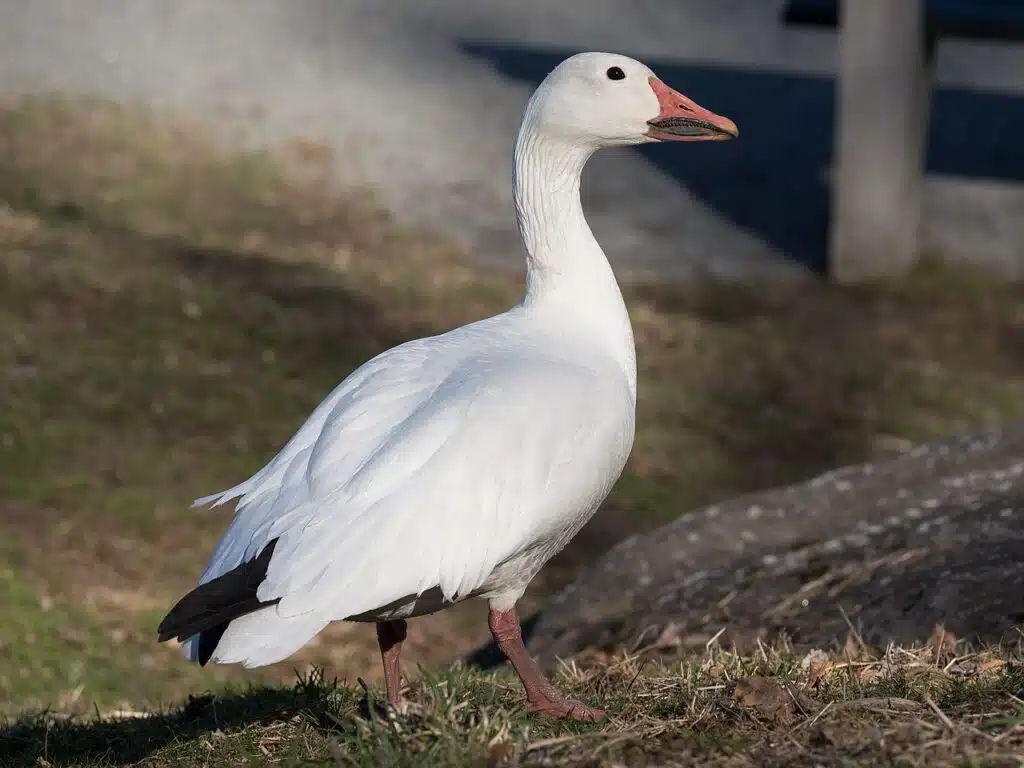
Most types of Snow Gooses (Anser caerulescens) are mostly white, as their name implies. They may only show black feathers on their tails.
Rare Snow Goose morphs that aren’t white also exist. A blue-gray morph is also characteristic of this species.
Growing up to a size of 31 inches, these birds are among the few species to live in the Northern Canadian Territories.
They move further South to overwinter, normally in large groups.
Some stray groups of Snow Goose have even made it to Greenland or The United Kingdom.
While common in North America, this is also a species impacted by various diseases the most recent bird-specific cholera.
Distribution – Alaska, Yukon (Canada), Nunavut (Canada), Hudson Bay (Canada), United States, Gulf of Mexico
Migratory – Partially migratory
8. Wood Stork
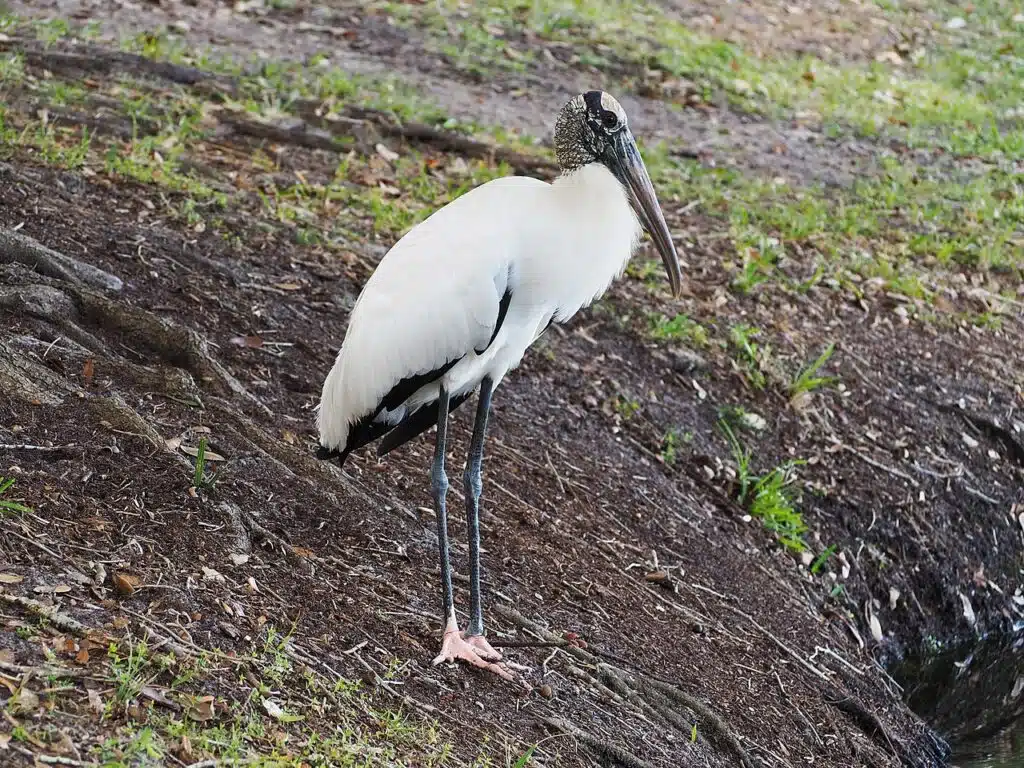
A mostly white appearance best describes the appearance of a Wood Stork (Mycteria americana). These birds have a dark neck and head, together with a black or black and brown bill.
This species is mostly found in South America and Central America.
It follows areas where water levels may change quickly as it lives in shallow water where it looks for fish and amphibians.
Mostly found in tropical and subtropical climates, Wood Storks make it further North on occasion, reaching Florida and The Southern US.
Lowlands and wetlands across this area attract a higher number of birds each year.
Distribution – South America, The Caribbean, Central America Southeastern United States
Migratory – partially migratory
9. Trumpeter Swan
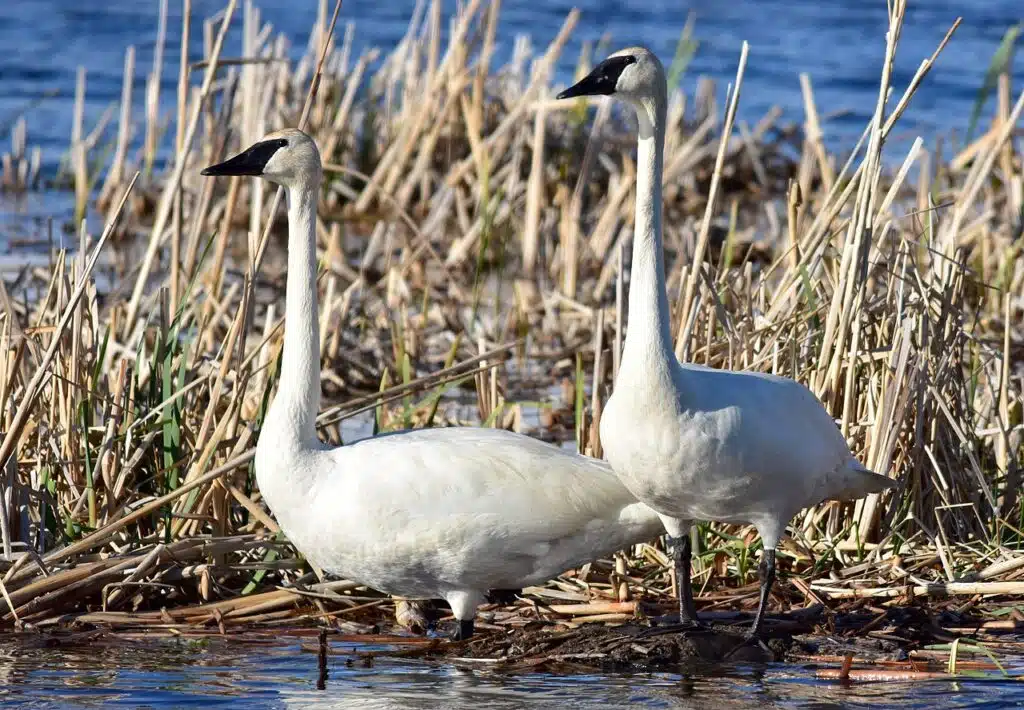
Trumpeter Swans (Cygnus buccinator) are the largest type of wild bird in North America. These types of birds have a purple-white color with a black beak.
They grow to a maximum size between 4 and 5 feet, sometimes reaching a size of over 5 feet in areas with plenty of food.
Its range may be subject to seasonal changes. Populations in its Northernmost range may migrate South to Montana and nearby states.
The Pacific Coast populations living in Canada and Alaska are the most likely to migrate. Year-round populations are found along The Rocky Mountains and in the inner states.
Trumpeter Swans like to eat various types of aquatic plants and flowers. They may also eat insects.
Males of the species also stand out with their habit of building nests before initiating courtship.
Distribution – Northwestern North America, United States
Migratory – Partially migratory
10. Tundra Swan
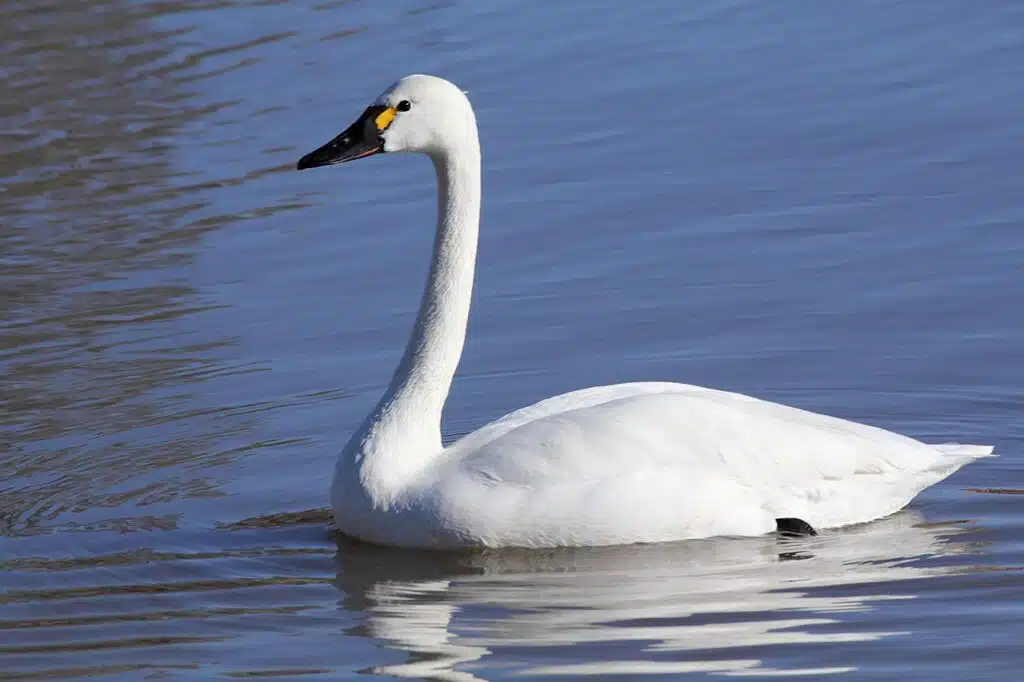
Most Tundra Swans (Cygnus columbianus) are almost completely white, except for their beaks.
The beak of the species is dual-colored and it may be yellow and black or orange and black.
Birds of the species are found in shallow water where they feed on different types of aquatic plants and grasses.
They can even pluck their heads underwater to reach the underwater parts of the plants.
Tundra Swan populations are stable. It’s believed there are almost 200.000 Tundra Swans in North America alone.
Many Tundra Swan populations move across The Rockies for food, flying inland from their Western and Northwestern North American habitats.
Distribution – Northwestern and Eastern Canada, Northern Canada, Alaska, and the Western United States
Migratory – Yes
11. Snowy Owl
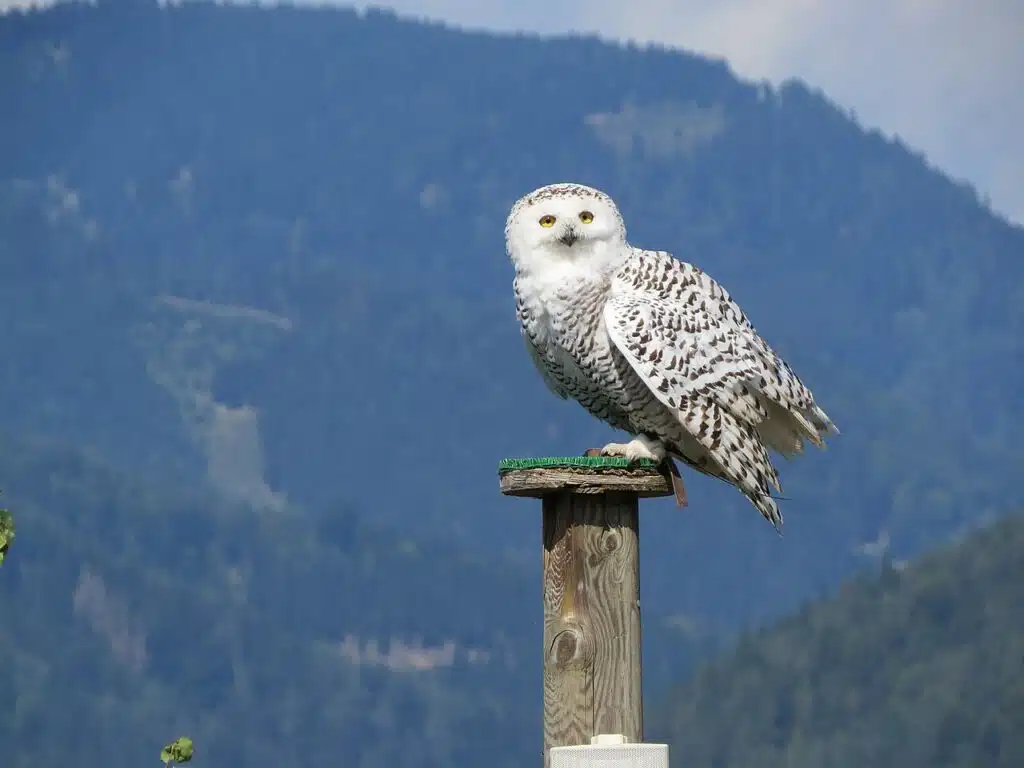
A Northern Hemisphere species, Snowy Owls (Bubo scandiacus) are the only true owl to be dominated by white plumage.
Brown sections are also seen on the species with some differences in its coverage between the sexes. Males are more likely to have larger white areas along the body.
This species may grow to a size of over 20 inches with sufficient food.
It comes out at night for food in some of the coldest remote areas of the world. A migratory bird, Snowy Owls rarely come back to the same place to breed.
These birds may show specialized eating habits in some parts of their range. On some small islands, Snowy Owls only eat lemmings, a type of rodent.
The complex mating habits of the species include male provisioning as male owls bring food to the nest.
Distribution – Arctic Regions, Canada, Northern US, Scandinavia, Northern Russia
Migratory – yes
12. Northern Gannet
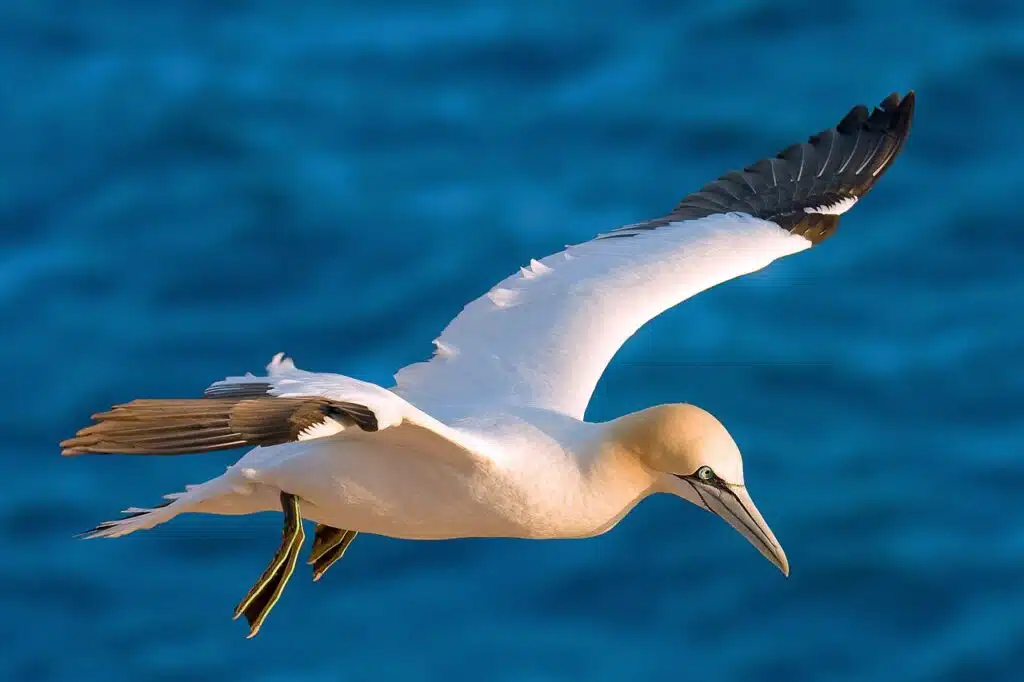
Northern Gannets (Morus bassanus) are named after their North Atlantic distribution. Birds of the species have mostly white coloring with black wing tips.
Yellow buffs are also seen on its crown and chest as it enters the breeding season.
Northern Gannets are among the largest species of white birds in the world. They can grow to a size of just over 40 inches while their wingspan can measure more than 70 inches with the largest individuals.
Their large size has even made them a target as they used to be hunted.
A coastal species, Northern Gannets may be seen in large colonies in coastal areas of Northern Europe and Eastern North America.
These birds are also known to have very loud vocalizations.
Distribution – Northeastern North America, Northern Europe
Migratory – Yes
13. Ross’s Goose
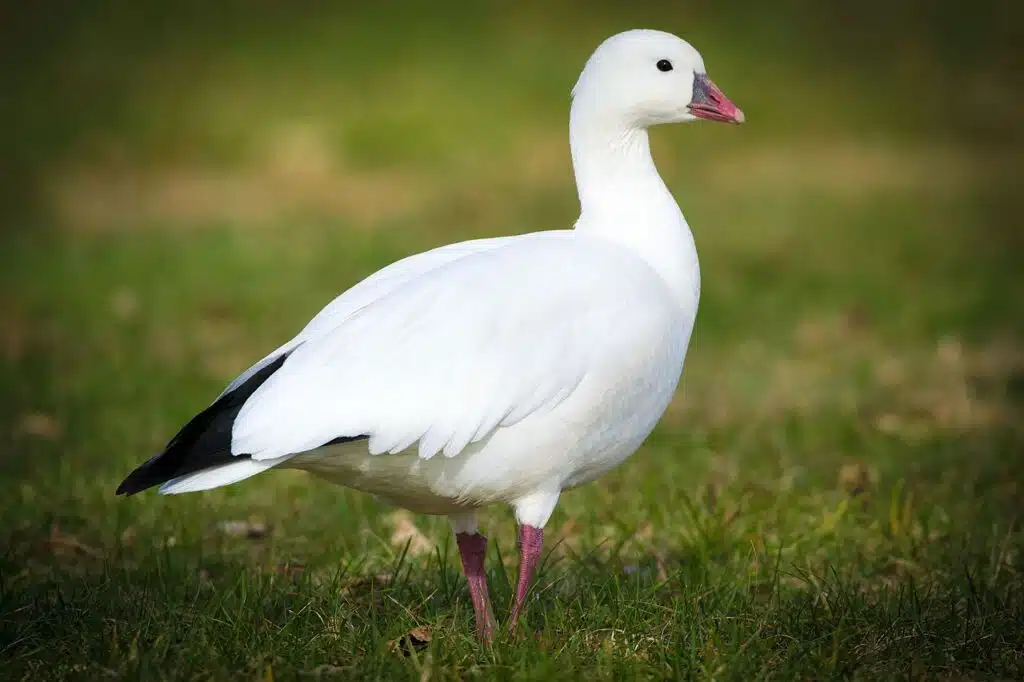
A species of The Arctic Tundra, Ross’s Goose (Anser rossii) is a bird that mostly comes in white plumage.
Some rare dark morphs of the species are also seen in some years. A gray morph tends to be the most common after its main white appearance.
Living in flocks, these birds grow to a size between 23 and 25 inches
and are found around different regions of North America depending on the season.
They might be found in the Northern territories throughout their breeding season and further South in the wintertime.
Open flatlands as well as low vegetation tundra in Northern Canada attracts Ross’s Gooses.
Some of its populations have even been found in Texas and Mexico for their overwintering period.
Distribution – Central Arctic, Canada, United States, Northern Mexico
Migratory – Yes
14. Whooping Crane
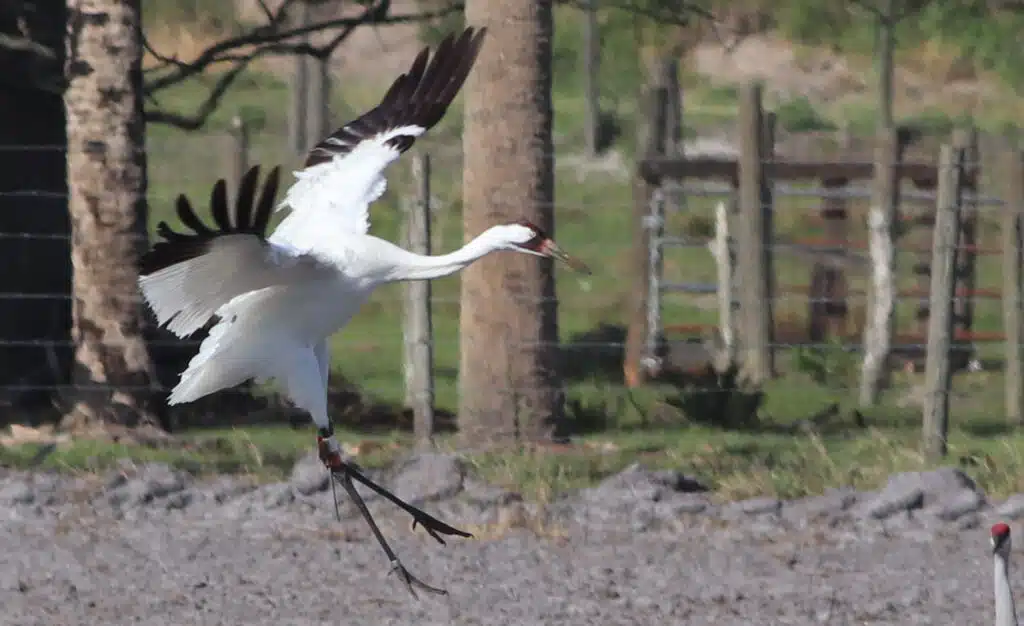
One of the largest white birds in North America, Whooping Cranes (Grus americana) grow to a size of at least 4 feet.
These birds live in very specific climates and migrate South to overwinter. They may reach Texas, The Gulf of Mexico, or even Mexico in their migration.
A typical Whooping Crane is a species that has white plumage and a red beak. Many of these birds also have a red crown and an orange beak.
Much of their diet is set by their habitat. An omnivorous species, these birds eat insects, snails, mollusks, and aquatic plants.
Distribution – Canada’s Northern Territories, Wisconsin
Migratory – Yes
15. Willow Ptarmigan
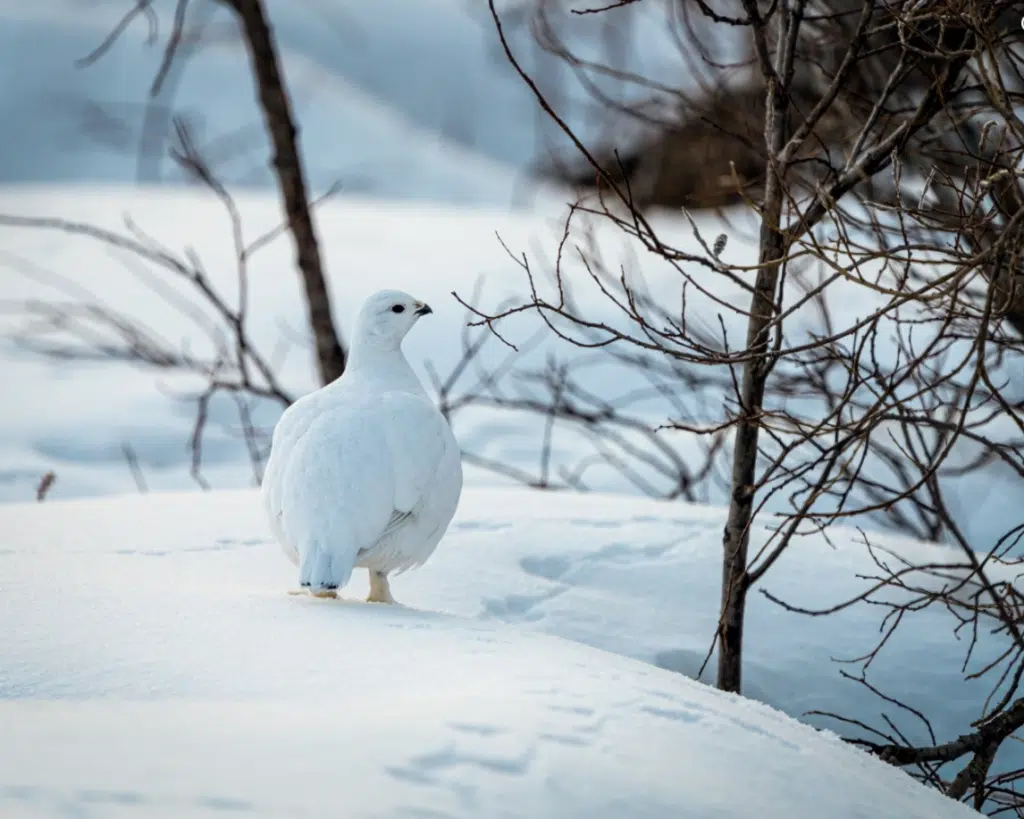
Much of the appearance of The Willow Ptarmigan (Lagopus lagopus) is white. While its appearance changes, this type of bird is always when not breeding.
Adults of the species take on a partially-brown appearance in their breeding season. These birds have red eyes and a black and white beak when their breed.
Much of their range impacts their appearance. These birds are often found in snow as they inhabit the Northern territories of Canada and Alaska.
Their camouflaging white color often helps them stay clear of potential predators.
A brown head, neck, and back are specific to these birds in the summer breeding season. This means they are difficult to spot both in the snow in the winter and the tundra in the summer.
Distribution – Alaska, Canada
Migratory – partially migratory
16. White Tern
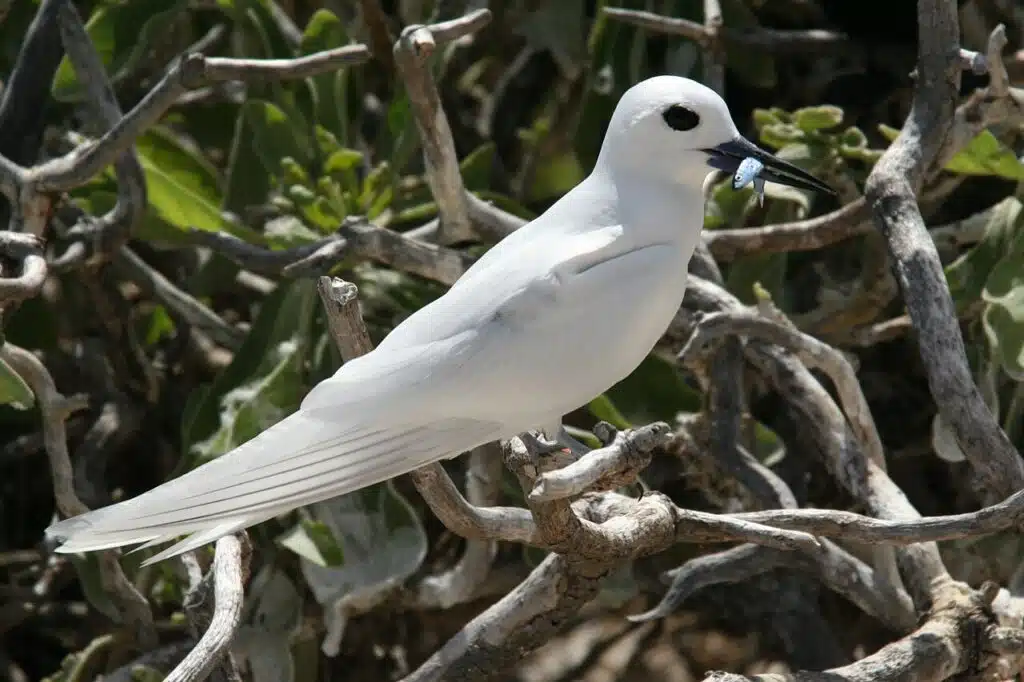
A completely white appearance is characteristic of White Terns (Gygis alba). These are birds that also have split white tails.
Much of their presence is tied to the islands in The Indian and the Pacific Oceans with a habitat spreading from the East African Coasts to Hawaii.
Much of its presence on these islands is sedentary and even use as navigation as the presence of these birds is used to confirm the land is close to sailors.
Depending on their range, these birds can also have many predators. Giant turtles are among the species that eat their eggs.
Distribution – Indian Ocean, Pacific Ocean
Migratory – No
17. Red-tailed Tropicbird
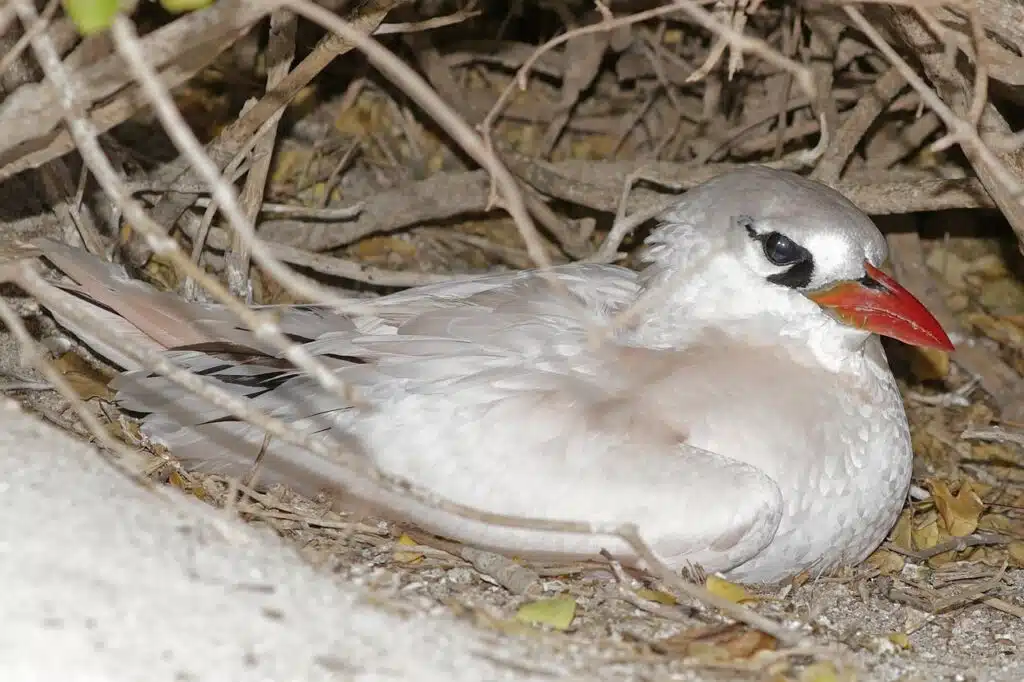
Almost completely white The Red-tailed Tropicbird (Phaethon rubricauda) has a long red tail and an elongated red beak.
Its head also features a contrasting black mask.
Its 4 subspecies are adapted to open waters and flying fish diets.
Birds of this species live in an extensive habitat of The Indian Ocean from East Africa to Indonesia.
They also live across The Pacific Ocean and The South Pacific.
Males of the species have multiple courting tactics such as flying up or even backward when circling females.
Distribution – Indian Ocean, Oceania, Pacific Ocean
Migratory – partially migratory
18. Rock Ptarmigan
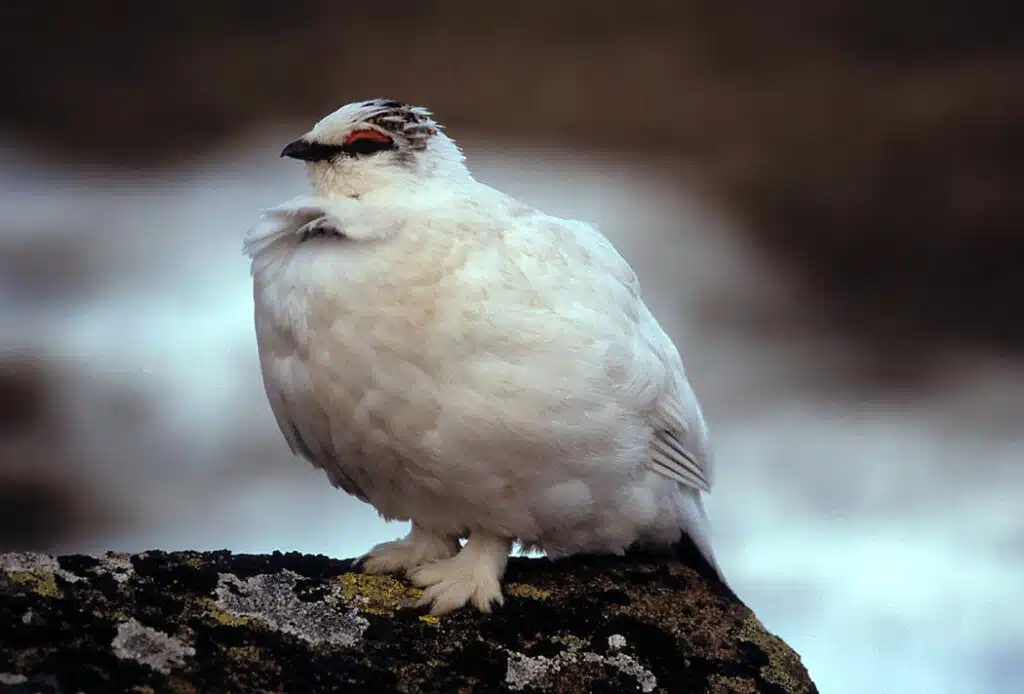
Cool Northern territories of North America, Europe, and Asia are home to Rock Ptarmigan (Lagopus muta).
This is a species with an official bird status in Canada’s large Nunavut region.
Its appearance changes with the seasons and improves its self-defense techniques when it comes to camouflaging.
This bird is mostly white with a contrasting black tail during the winter. It changes its appearance to brown for the spring and summer months which may make it more difficult to spot in the tundra.
Birds of this family grow to a size of around 14 inches and have an adapted diet depending on the season.
They can eat various berries in the spring and summer months and even eat willow tree leaves.
Distribution – Northern Canada, Northern Europe, Northern Russia, East China, Japan
Migratory – partially migratory
19. Little Egret
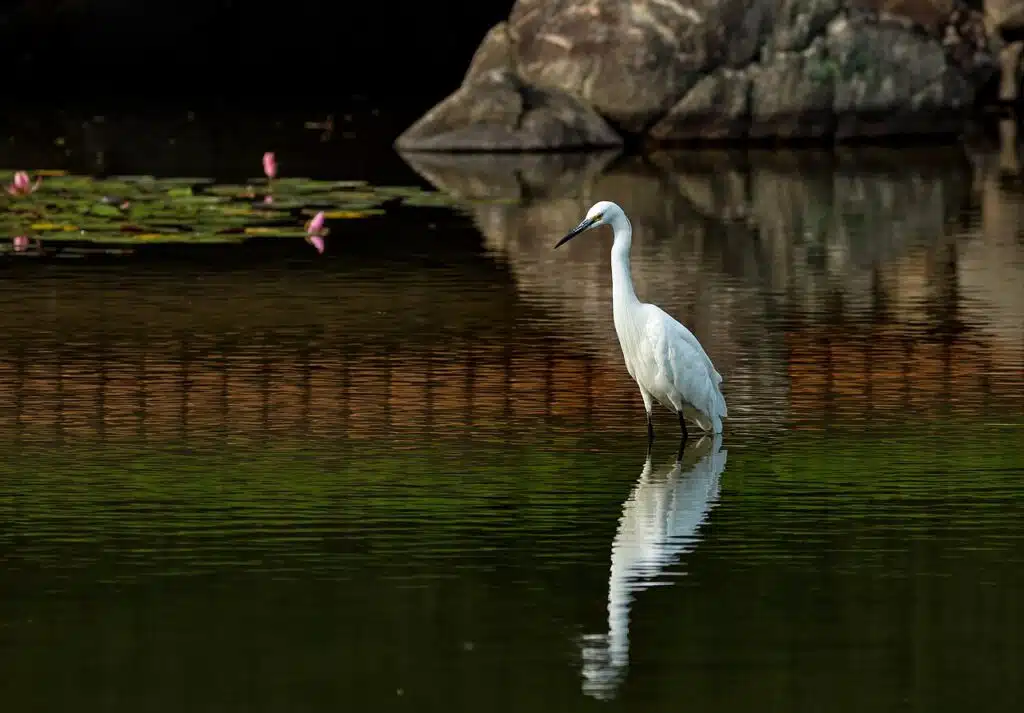
Growing to a maximum size of 26 inches, Little Egrets (Egretta garzetta) are birds that may have a double wingspan.
Mostly white, these birds have a black beak and black legs.
Rarely present in North America, Little Egrets have a permanent status in many sub-Saharan countries as well as in Northern Africa.
Middle Eastern populations may migrate, as do some of its Asian areas.
This species is also highly present across Australia.
Little Egret also migrates to Europe during the spring and summer breeding months before making their way back to Northern Africa.
Distribution – sub-Saharan Africa, Southern Asia, Australia
Migratory – partially migratory
20. Ivory Gull
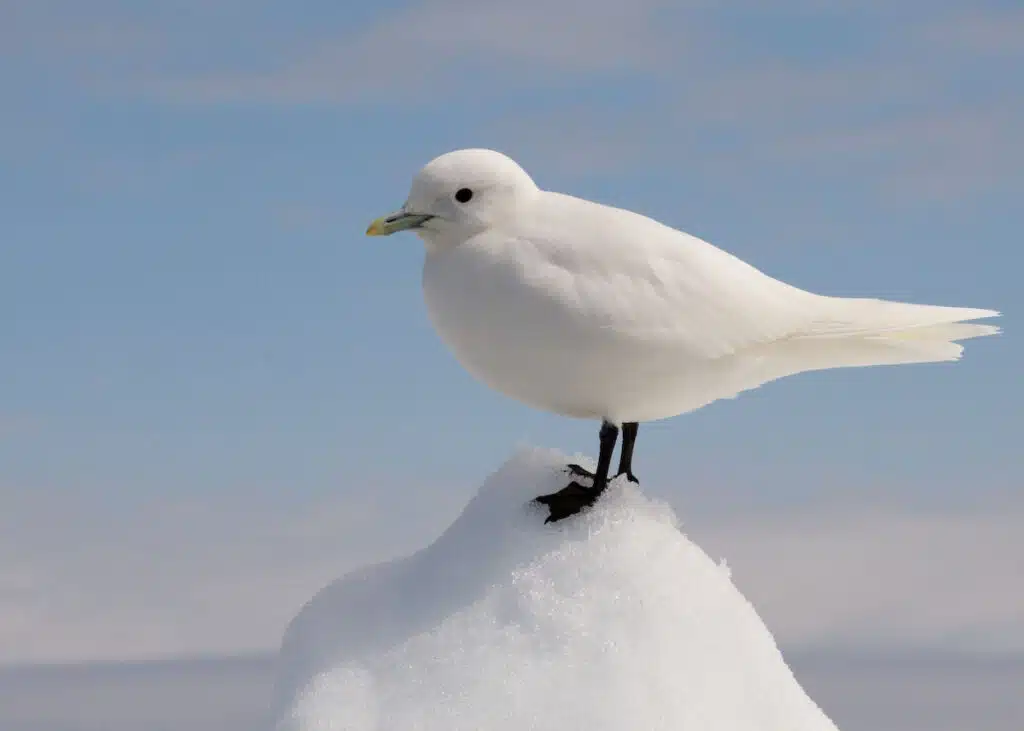
Ivory Gulls (Pagophila eburnea) are completely white. They only have a black beak and contrasting black legs.
Living in some of the coolest habitats, these gulls may use their white color as camouflage in the snow.
Opportunistic feeders are known to eat anything they can find from fish to carrion.
Various types of carcasses are often places where Ivory Gulls gather for food. They are also seen fighting polar bears caught for carrion.
Growing to a maximum size of 16.9 inches, this species has a numerous presence in North America.
Distribution – Canadian Arctic, Greenland, Northern Scandinavia
Migratory – Yes
21. Whooper Swan
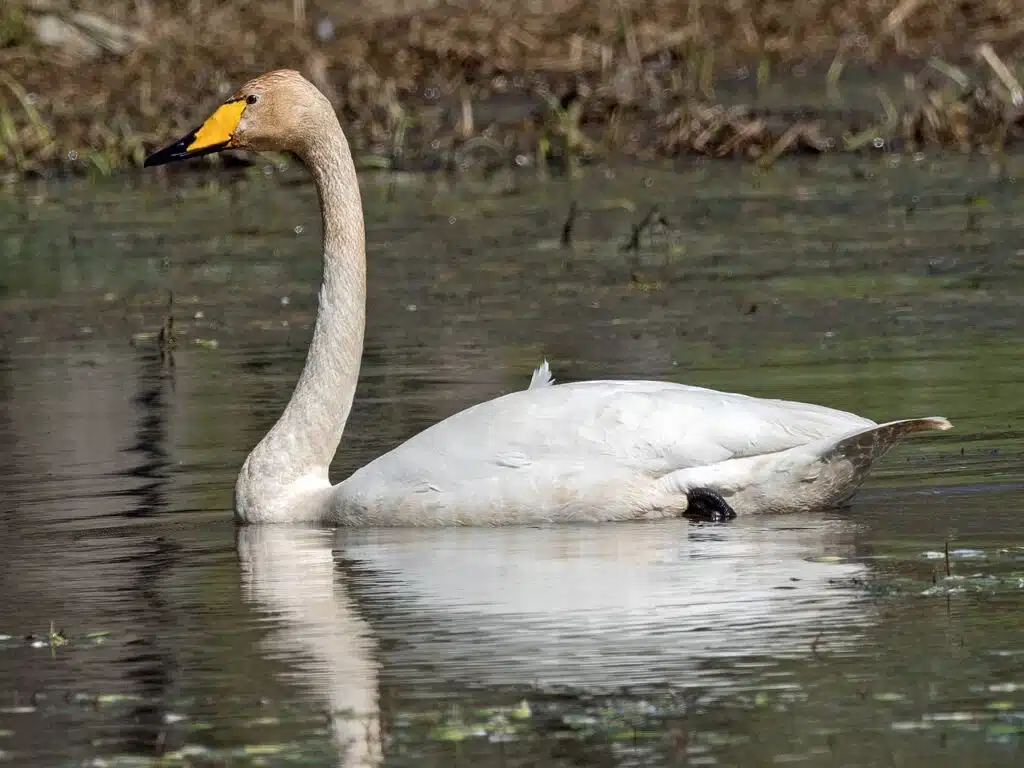
Growing to a size between 50 and 65 inches, Whooper Swans (Cygnus cygnus) are some of the bulkiest and heavies types of white birds.
Known for their elongated heads, Whooper Swans have a bright yellow and black beak and an all-white appearance.
Eurasia marks the natural habitat of these swans with known breeding and overwintering grounds.
These swans make their way to vast open areas of Russia and Scandinavia before returning to Europe to their overwintering ground.
Soon after breeding, the female Whooper Swan lays 3-4 yellow eggs.
Spending its time in shallow water, this species feeds on aquatic plants.
Distribution – Europe, Russia, Mongolia
Migratory – Yes
22. Salmon-crested Cockatoo
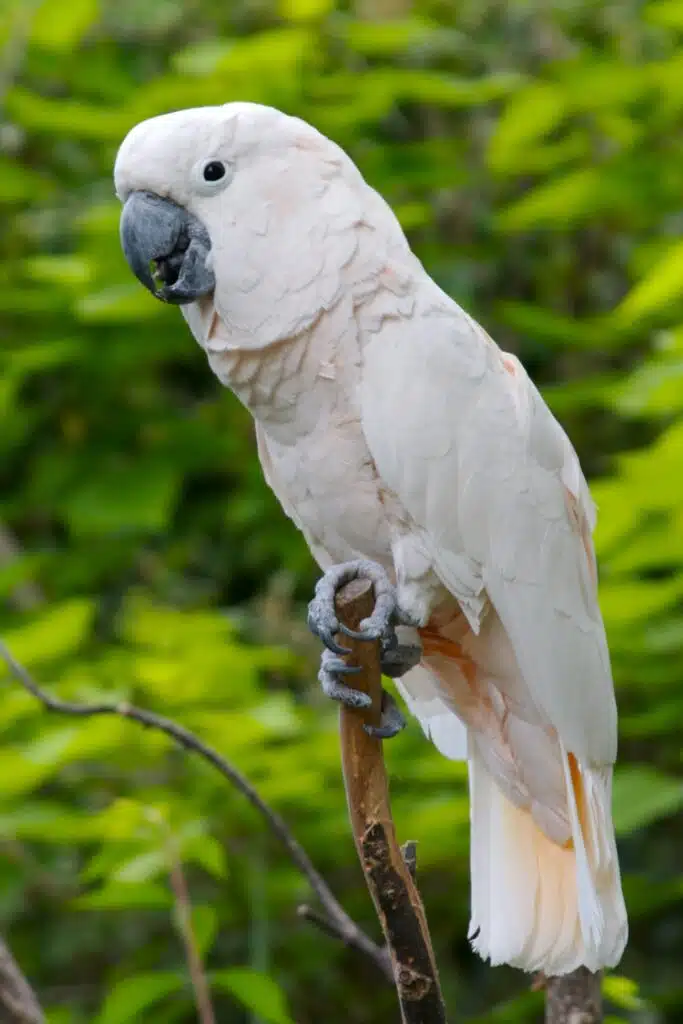
An Indonesian native, The Salmon-crested Cockatoo (Cacatua moluccensis) is a white parrot with a salmon-red crest.
This species has also been established in other areas outside of its native range such as Hawaii.
Seeds and fruits are among their most common foods.
Often raised in captivity, these birds aren’t recommended to beginner parrot pet owners due to their very loud vocalizations.
Salmon-crested Cockatoo is believed to be some of the most adaptable parrots in captivity despite being some of the loudest parrots in the world.
Distribution – Indonesia
Migratory – No
23. Greater Flamingo
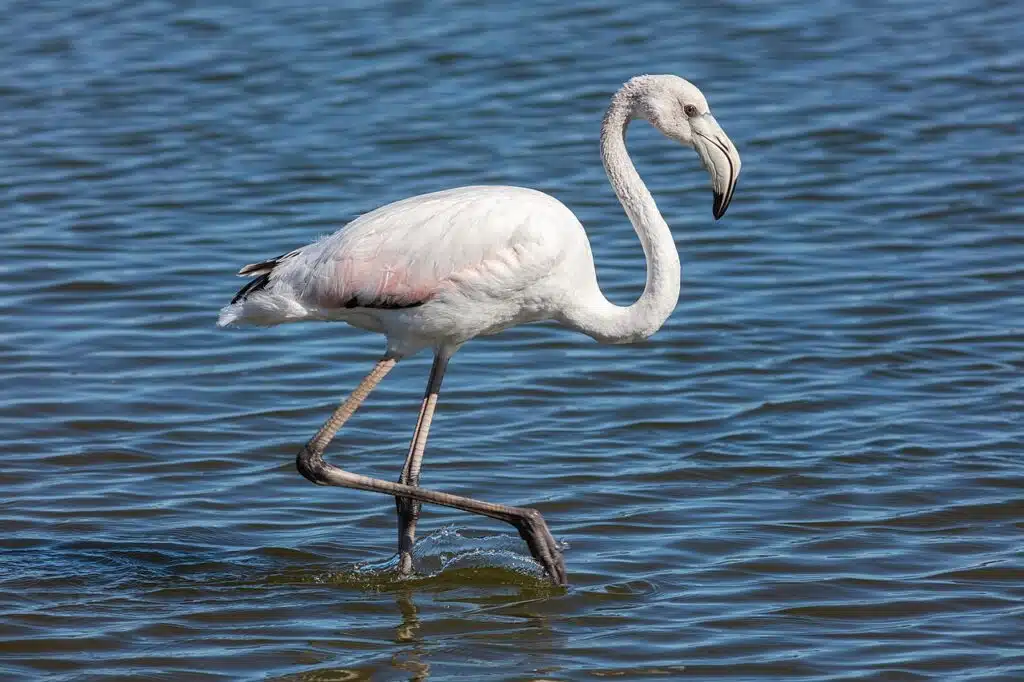
Pink-white coloring is one of the most common characteristics that make Greater Flamingos (Phoenicopterus roseus) known around the world.
This species shows a mostly white body and pink plumage with similar salmon-pink legs.
These types of flamingos are found in coastal areas where they look for food with the bill.
Eating habits involve sucking water for shrimp and small organisms.
Much of the habitat of the species is tied to warm climates in Europe, Africa, and Asia where the species may live for decades.
Distribution – Africa, Europe, Middle East, Asia
Migratory – No
24. Sulphur-crested Cockatoo
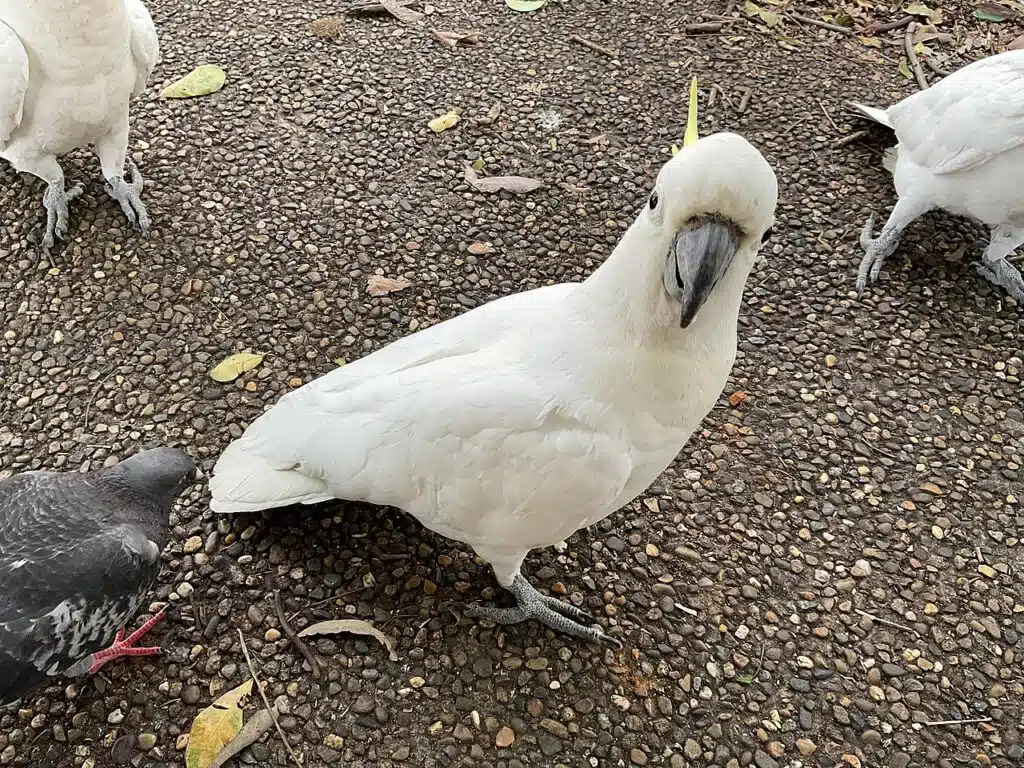
Sulfur-crested Cockatoo (Cacatua galerita) is native to Australia. An upward-facing yellow crest is characteristic of this bird.
These types of parrots live throughout Australia but they may be seen as pests on crops and gardens.
Living in small groups, Sulphur-crested Cockatoos tend to invade fruit-rich areas such as crops.
They may also feed on cultivated cereals.
While they don’t live as long as Greater Flamingos, Sulphur-crested Cockatoos may still live up to 40 years.
A protected species in Australia, a mature parrot of this species may grow to a size of 21 inches.
Distribution – Australia
Migratory – No
25. Eurasian Spoonbill
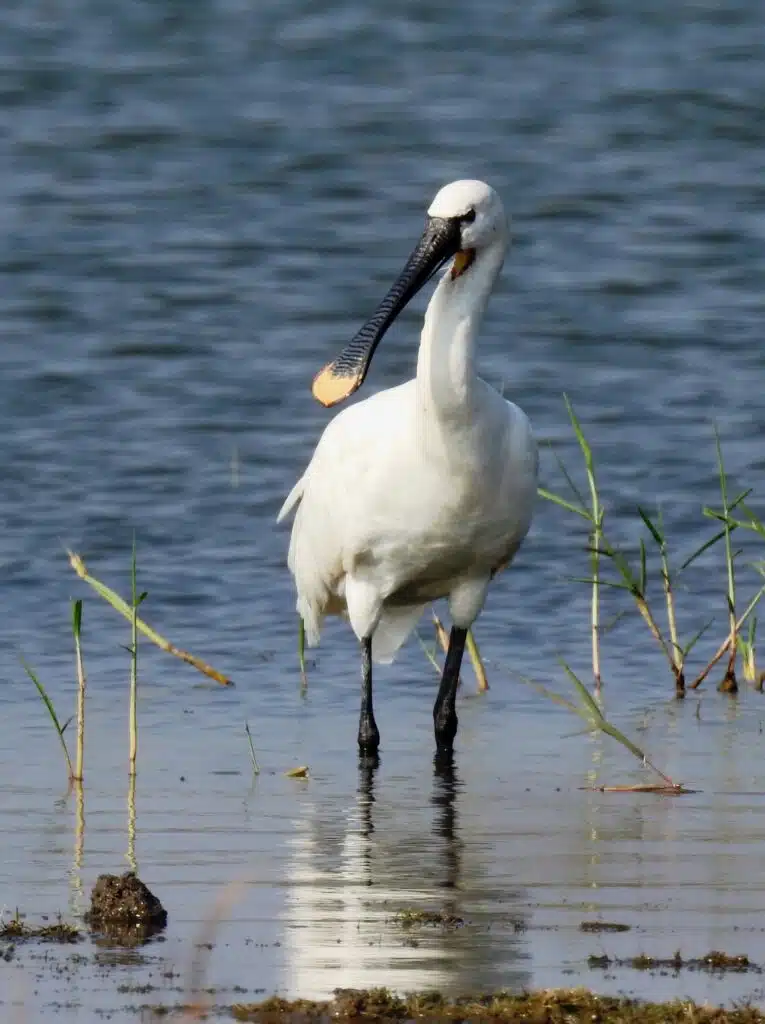
A white appearance is specific to The Eurasian Spoonbill (Platalea leucorodia). This species has a black long and white bill and black contrasting legs.
This species is mostly seen in colonies in coastal Europe. Unlike other coastal species, The Eurasian Spoonbill can be noisy but it’s generally silent.
Its diet is diverse and it includes both animals and plants. It also eats crustaceans and insects.
These types of birds tend to filter out fish with their beaks after sucking in water.
They live in Europe for Africa to overwinter.
Distribution – Europe, Africa, Asia
Migratory – Yes
26. Little Corella
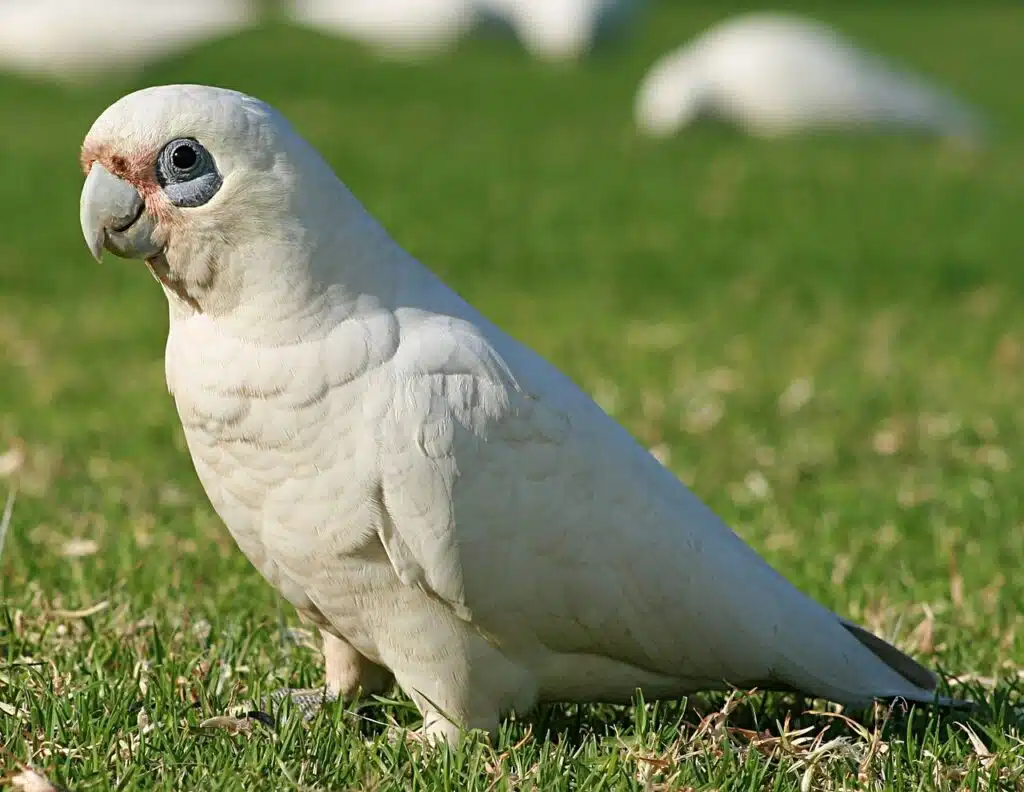
Reaching a size of up to 16 inches, Little Corella parrots (Cacatua sanguinea) are mostly white with a white crest.
These parrots have bright blue eyes and are endemic to New Guinea.
Highly noisy, these types of parrots build nests on trees.
They are among the species that also invade crops and gardens. Cereal crops are among the most common areas these types of parrots invade in pairs or small groups.
This type of parrot can make different noises. High-pitched noises are mostly characteristic of the species.
Found in 4 subspecies, Little Corellas also have cultural importance with their feathers used in traditional rituals.
Distribution – New Guinea
Migratory – No
27. Intermediate Egret
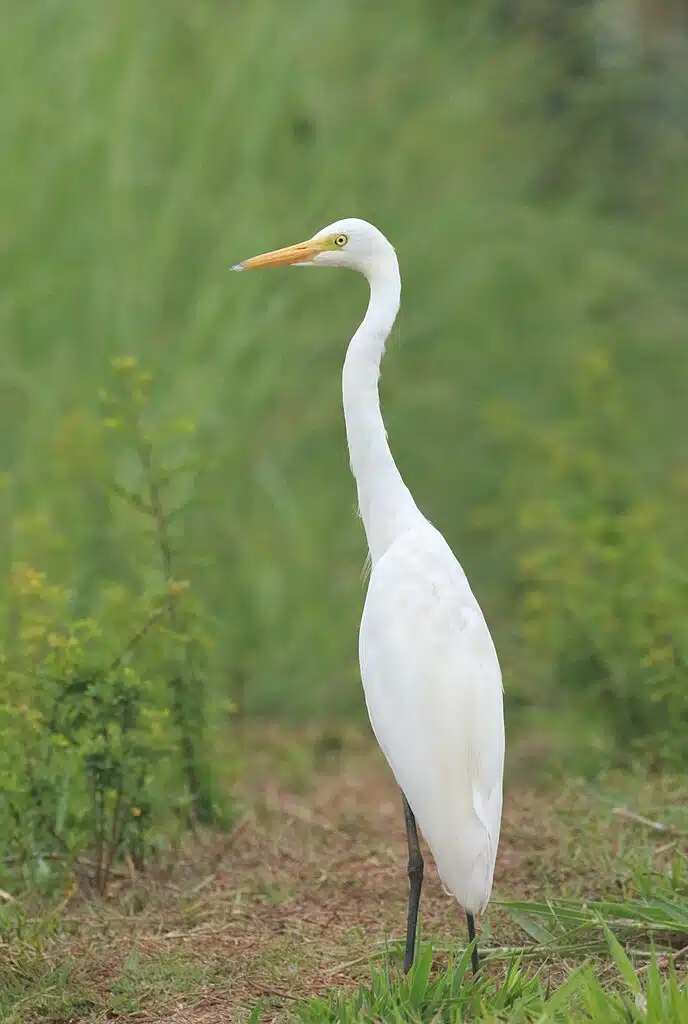
A worldwide species with white plumage, Intermediate Egret (Ardea intermedia) has a white body and a yellow beak.
These types of birds are in coastal areas as well as in freshly-flooded areas where there’s food such as fish.
They are found in vast coastal areas along Africa as well as in Southern Asia and down to Australia.
Blue skin sections appear on its face during the breeding period.
Females of the species are known to lay a small number of pure white eggs immediately after breeding.
Some Southeast Asian Intermediate Egret may migrate to overwinter.
Distribution – West Africa, East Africa, Southern Asia, Australia
Migratory – partially migratory
28. Royal Spoonbill
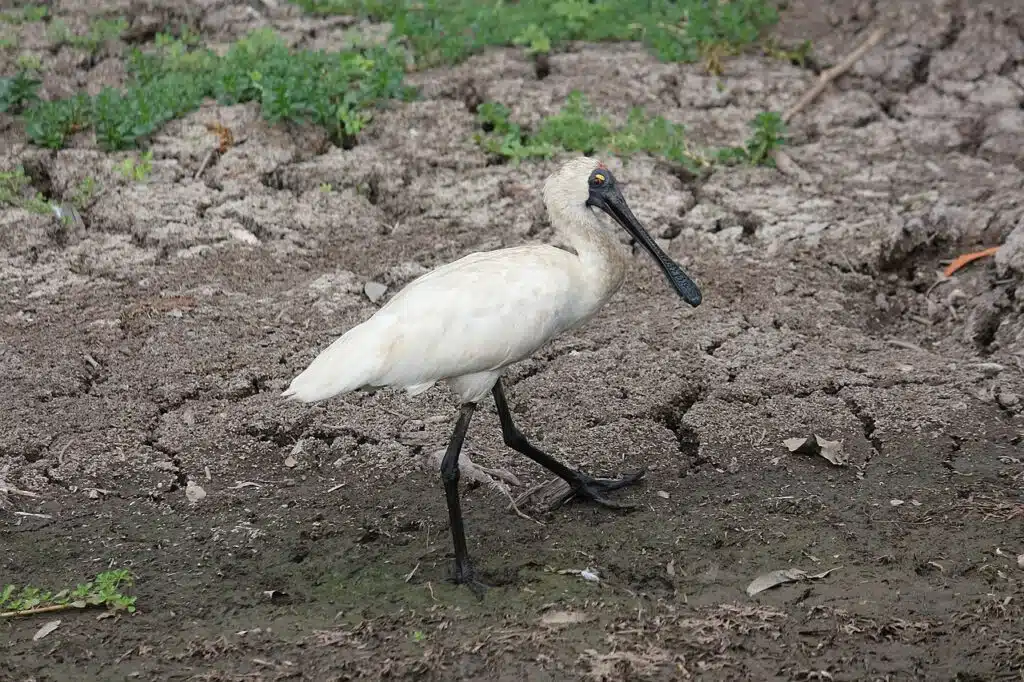
Royal Spoonbill (Platalea regia) is a white bird species name after the shape of its bill.
Its elongated black bill is wider at the tip. Shaped like an upper and lower spoon, its bill helps it feed easier.
While the bird remains white even in its breeding season, it still shows long white feathers at the back of its head to mark the breeding period from the rest of the year.
The size of this species varies but the average Royal Spoonbill grows to 30 inches.
Most of its populations are found in Australia.
Distribution – Australia, New Guinea, New Zealand, New Caledonia
Migratory – No
29. Great White Pelican
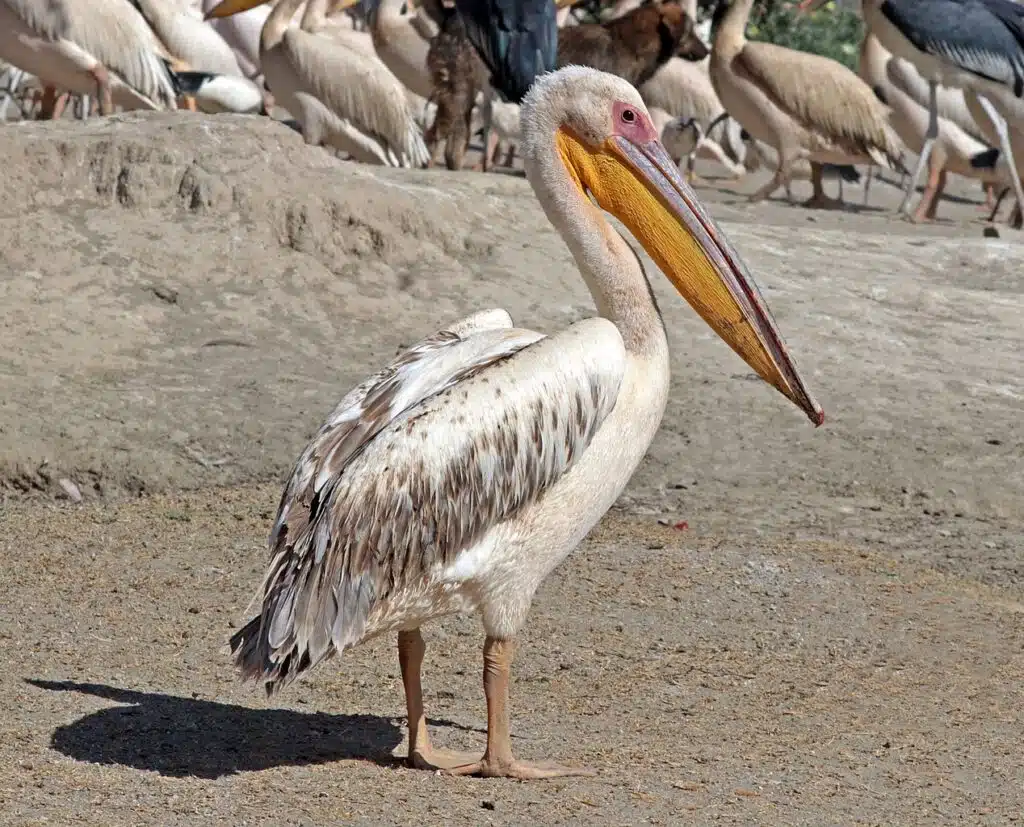
Growing up to 71 inches, Great White Pelicans (Pelecanus onocrotalus) are some of the largest types of white birds in the world.
This species also have a very long and wide yellow beak.
Most of its plumage is white while its wings may be gray, dark gray, or black. The juvenile Great White Pelican has a darker appearance, dominated by shades of gray.
A Eurasian species, this type of pelican lives around The Black Sea and The Caspian Sea.
Smaller populations live on the shores of The Adriatic Sea and the shores of The Mediterranean.
This is a species that migrates very long distances to overwinter
Some of its longest migration routes take the large bird to South Africa.
The migration process is collective and flying Great White Pelicans are seen moving in a V-shaped formation to their overwintering spots.
Distribution – Croatia, Romania, Bulgaria, Ukraine, Azerbaijan, Turkmenistan, Uzbekistan, Kazakhstan, Northeastern Africa, sub-Saharan Africa
Migratory – Yes
30. Coscoroba Swan
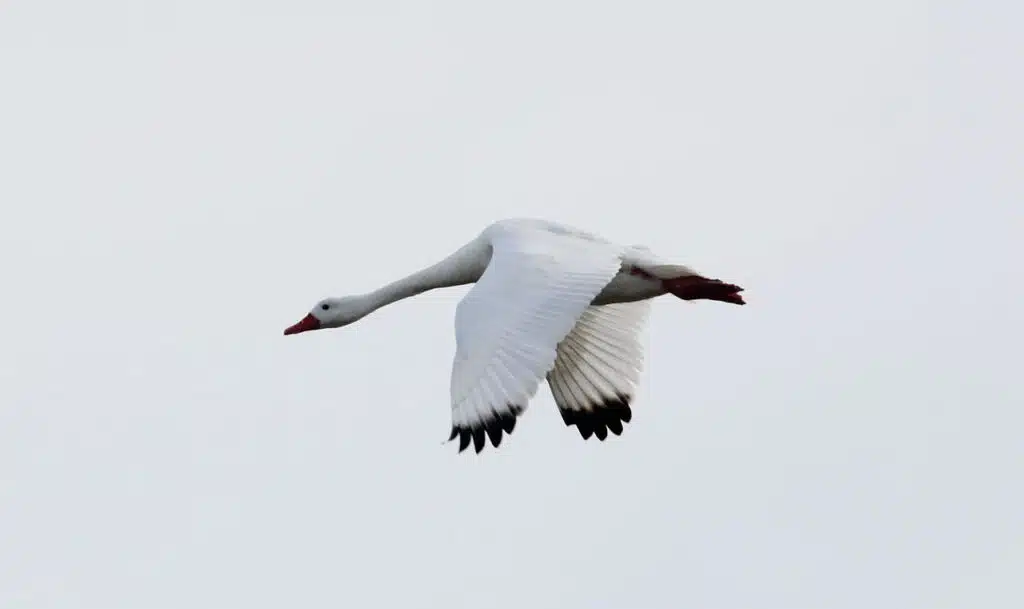
A South American species, the Coscoroba Swan (Coscoroba coscoroba) grows to a size of just over 40 inches.
It features all-white plumage and a red beak. The beak of the species is wider at the tip.
Some populations of these swans show a migratory status while others are permanent residents of their countries.
They are found in coastal areas and along other temporary water sources.
The wintertime marks the period this species may seek out overwintering locations. Many Coscoroba Swans overwinter either in Argentina or Chile.
Remote South American Islands also provide safe overwintering coastal areas for these swans. Such islands include The Falklands.
The diet of the species is very diverse. Unlike other large white birds, it eats fish and insects but also plants.
Swans of this species feed both on aquatic and on dryland plants.
Distribution – Brazil, Chile, Argentina, Uruguay, The Falkland Islands
Migratory – Yes
31. Long-billed Corella
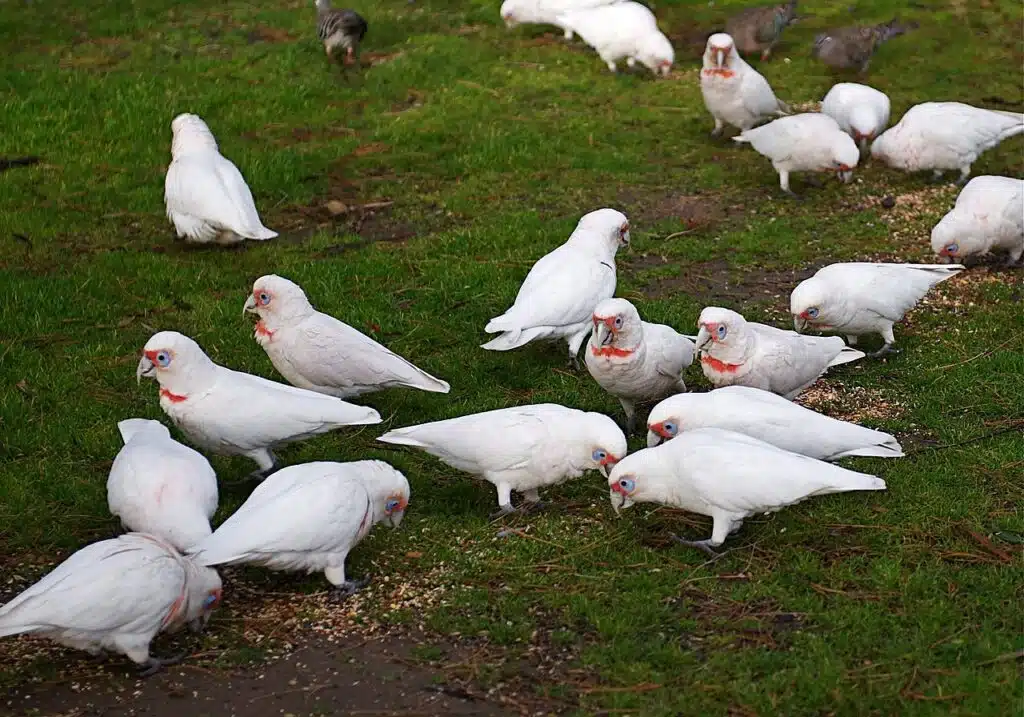
A mostly white parrot, Long-billed Corella (Cacatua tenuirostris) is a white bird native to Australia.
This species shows red or salmon plumage around the eyes and neck in the breeding season.
Outside its native Australia, Long-billed Corella is among the species most common among parrot collectors for their ability to mimic words.
Their imitations are considered among the best in the world of parrots.
In their native range, Long-billed Corella parrots may even be seen as pests, as many other parrots in Australia.
They can invade crops and damage various goods around homes and farms.
Some Long-billed Corella parrots have even been spotted chewing power lines.
Humans remain the biggest enemy of the species as these parrots are killed for the damage they create to fruits and cereal crops.
Distribution – Australia
Migratory – No
32. Little Blue Heron
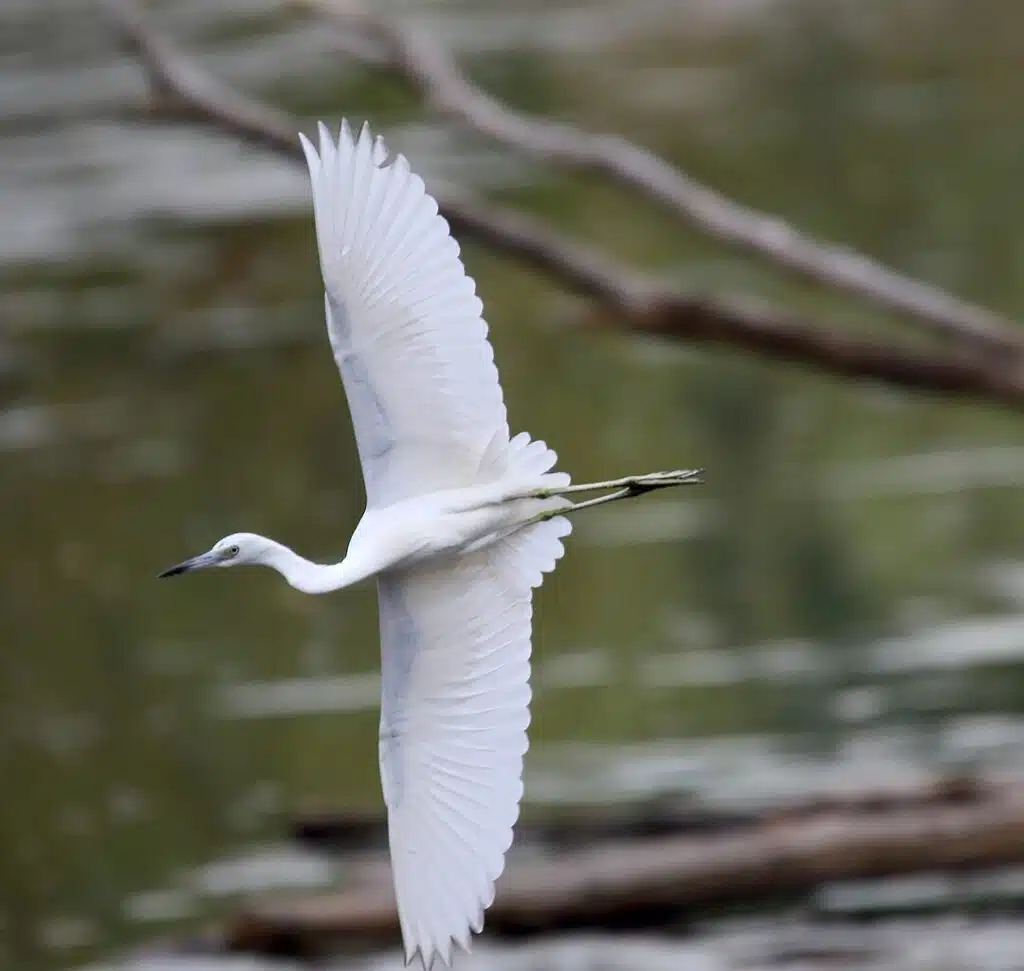
If adult Little Blue Herons (Egretta caerulea) are dark, their juveniles are completely white.
The juvenile bird may take months to become an adult and to turn darker.
Both juveniles and adults share the same habitat, spending much of their time looking for food.
Small fish are among the typical types of food this juvenile bird is interested in. It learns the right techniques for slow-moving adults.
These are some of the slowest types of herons by movement. They always walk in shallow water for food.
On occasion, they might fly for a nearby fish but prefer to move slowly so they remain undetected.
Found across Americans, these types of herons may migrate. Populations across North America are the only ones to migrate.
Typical overwintering spots include tropical and subtropical climates in Central America.
Most populations of Little Blue Herons, particularly those in South America, don’t migrate.
Distribution – Eastern and Southeastern US, Central America, The Caribbean, Northern South America
Migratory – Partially migratory
33. Kelp Goose
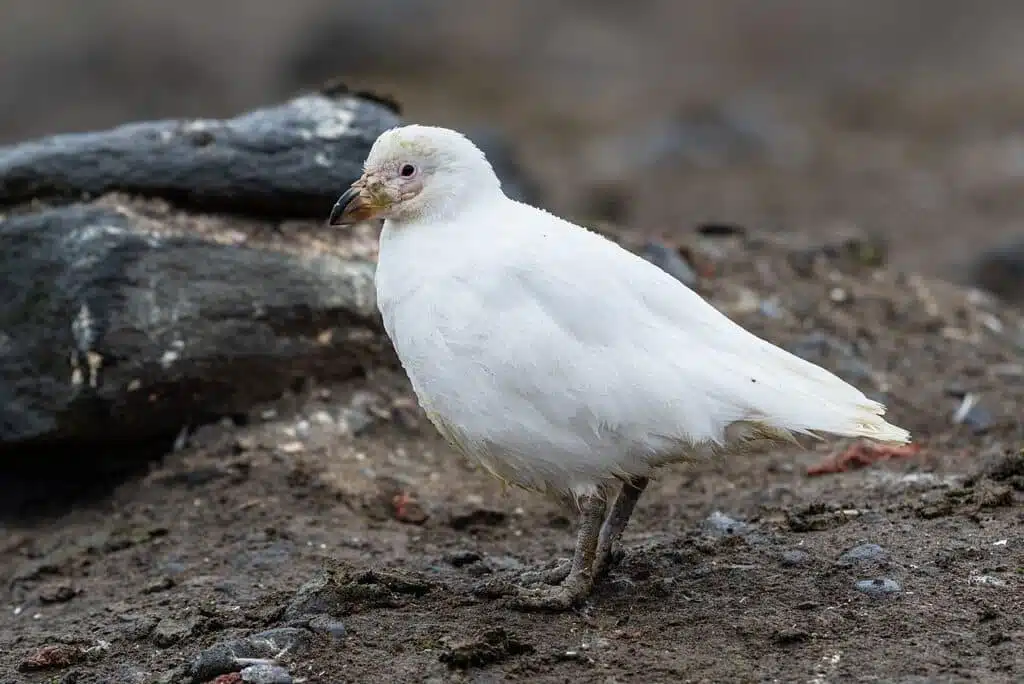
A mostly white male is characteristic of a rare species of goose known as the Kelp Goose (Chloephaga hybrida).
Males of the species are entirely white while females are dark. The female Kelp Goose has a black back with gray and white underbelly coloring.
Males and females only share a black beak as a characteristic of their appearance.
Kelp Goose lives in some of the most remote parts of South America. Found in coastal areas, they only inhabit the Southern parts of Chile and Argentina.
They can move along their territory, but these types of white birds never migrate.
Food abundance may change, but since they only eat plants they always found food nearby and this means they don’t need to migrate.
These types of birds can be seen in pairs after breeding as both males and females care for their young.
Distribution – Southern Chile, Southern Argentina
Migratory – No
34. Snowy Sheathbill

Snowy Sheathbill (Chionis albus) is completely white and the only true native species in Antarctica.
These types of birds spend much of their time on the ground but they can fly. They often migrate to the coastline of South America.
A completely white appearance is specific to these birds, as their name implies. A white and black beak is specific to the species.
A type of scavenger, Snowy Sheathbill are birds that can eat anything they can find.
These are the types of birds that may eat insects one day and carrion another day.
As omnivores, these birds spend less time looking for food compared to other types of birds in The Southern Hemisphere.
Distribution – Antarctica
Migratory – Yes
35. African Spoonbill
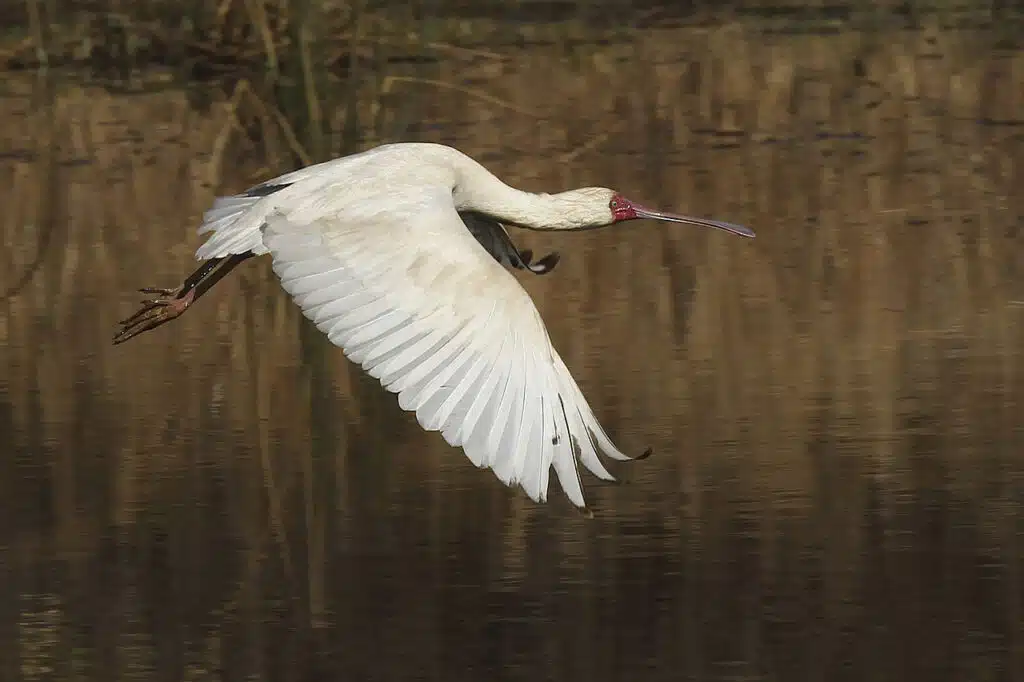
African Spoonbill (Platalea alba) has completely white plumage. These birds have white wings, a white underbelly, and a white head.
Their face has a red mask of a similar nuance to the base of their red beak.
African Spoonbills have a spoon-shaped bill. These types of bills are wider at the tip, making for quick species identification.
The long thin legs of these birds are also vivid red, just like the bill.
Shallow water and temporary water are common areas where the birds may be found in multiple African countries.
It’s here that the birds feed on various amphibians, reptiles, small snakes, fish, and crustaceans.
Distribution – Madagascar, Kenya, Namibia
Migratory – Yes
36. White-tailed Ptarmigan
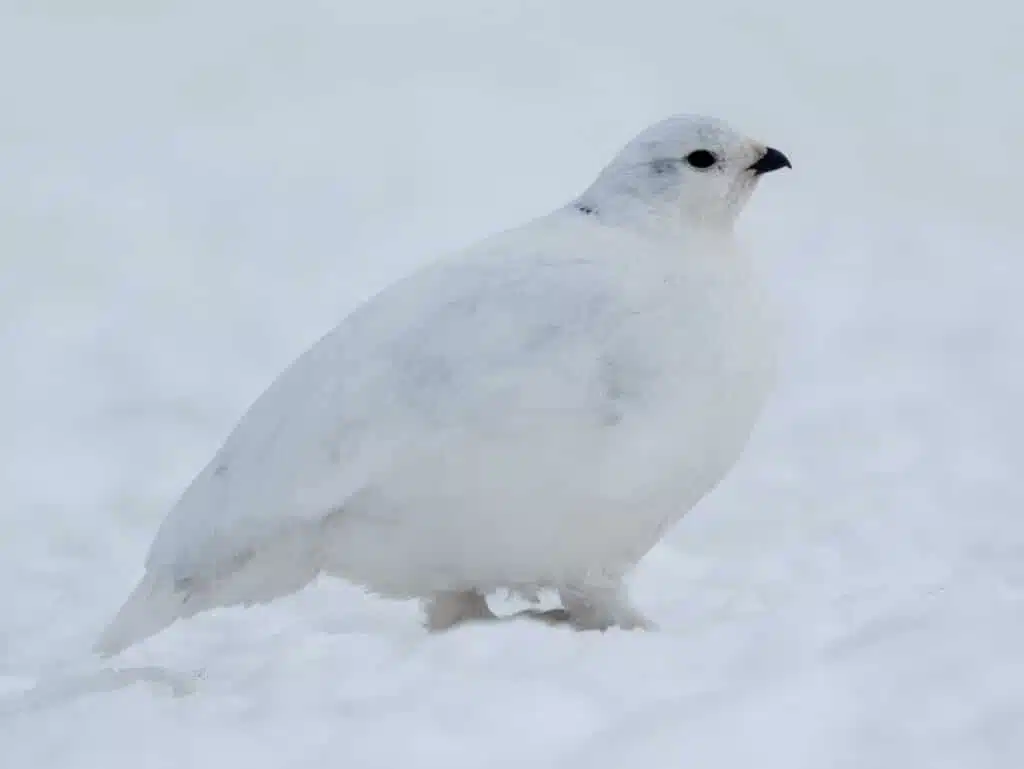
White-tailed Ptarmigan (Lagopus leucura) are completely white outside of their breeding season.
A white head, chest, belly, back, and wings are specific to these types of birds. Their appearance changes completely during the breeding season.
Their plumage darkens before the season to eventually become dark brown and gray.
Only its underbelly remains white while the rest of its body, including its head, becomes gray and brown, with white speckles.
These plumage color changes are characteristic of both males and females. These changes can be spotted every year.
However, males tend to have extra brown feathers compared to females. These elongated feathers are located around the crown.
Distribution – Southern Alaska, Northwestern Canada
Migratory – Yes
37. Yellow-crested Cockatoo
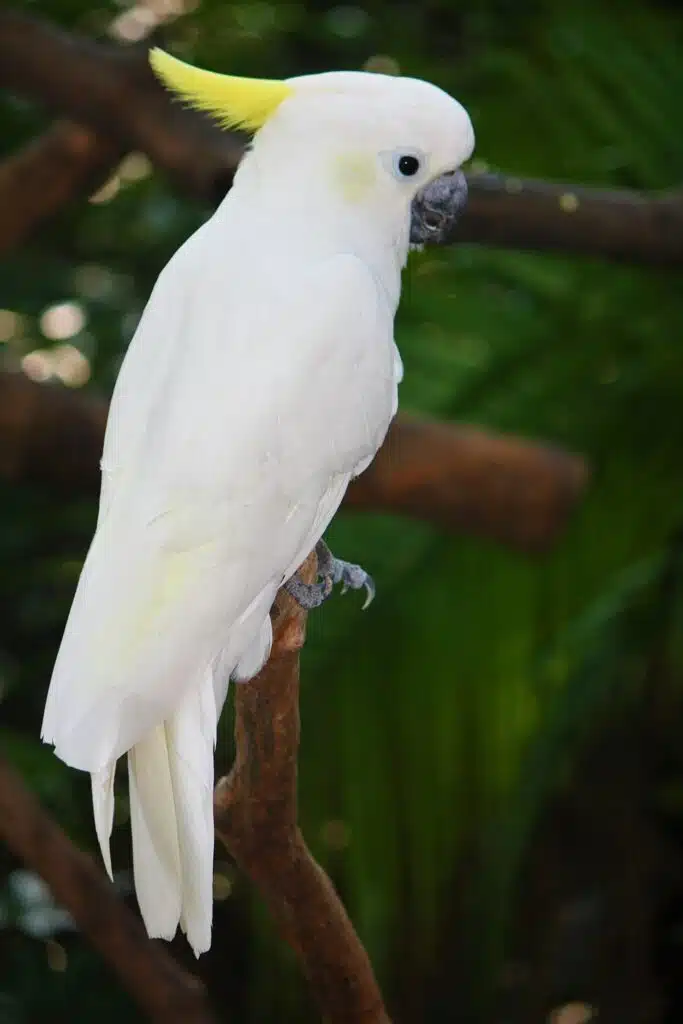
An almost completely-white appearance is characteristic of The Yellow-crested Cockatoo (Cacatua sulphurea).
Found around different Asian islands, this is a type of parrot that is also common as a pet parrot in captivity around the world.
Indonesia marks much of its territory.
This white parrot is raised for its mostly white look and yellow crest. Its cheeks may also turn yellow when the species enter the breeding season.
Distribution – Indonesia, Timor, Tanimbar Islands
Migratory – No
38. Tanimbar Corella
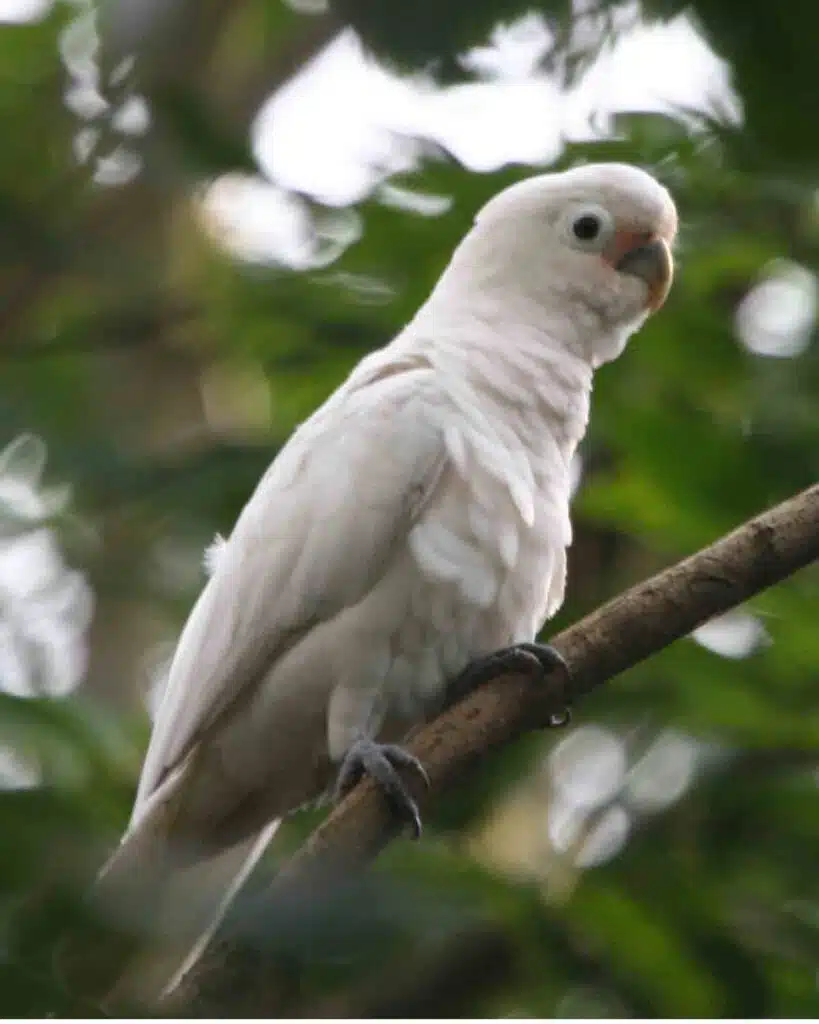
A white or a pink-white color is characteristic of The Tanimbar Corella (Cacatua goffiniana). This is a species mostly known for being a resident of Indonesia’s Tanimbar Islands.
It is also a highly common bird raised in captivity.
These birds are mostly white but take on salmon-pink coloring around the beak and on the face.
Juveniles of the species have a similar appearance with large black and white eyes and pink coloring on the face while their back, belly, neck, head, and wings are mostly white.
Distribution – Tanimbar Islands
Migratory – No
39. Black-faced Spoonbill
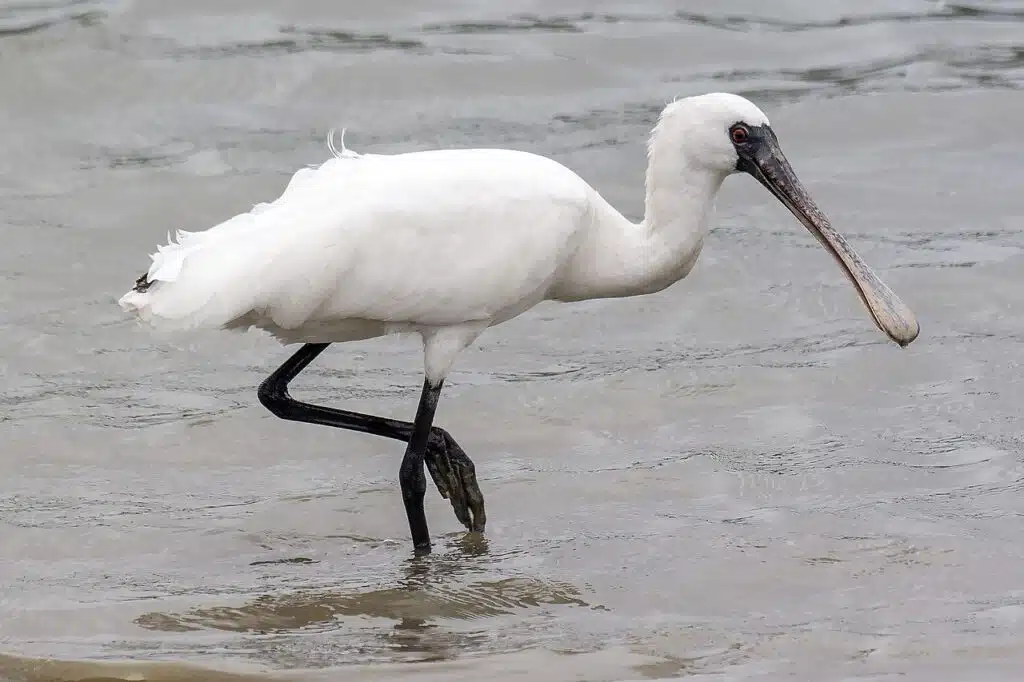
The Black-faced Spoonbill (Platalea minor) is one of the rarest types of white birds in the world.
While the numbers of these birds aren’t known specifically due to their migration, it’s estimated only a few hundred individual Black-faced Spoonbills remain in the wilderness.
White heads, backs, wings, and bellies are characteristic of The Black-faced Spoonbill.
The bill of the species has a wider tip which inspires their name.
Their legs are black while the upper chest may show a central yellow section.
One of the most threatened species in the world, these birds are protected in countries such as China.
Distribution – China, Philippines, Thailand
Migratory – Yes
40. Yellow-billed Spoonbill

Growing up to 35 inches, the Yellow-billed Spoonbill (Platalea flavipes) is a species with white plumage native to Australia and New Zealand.
This species also lives in coastal and shallow water on the small islands around Australia and New Zealand.
A long yellow bill is characteristic of this species, which is mostly white.
Much of their days are spent looking for food.
Yellow-billed Spoonbills use sweeping bill motions to catch fish and other animals in shallow water.
Distribution – Australia, New Zealand
Migratory – No
41. Jabiru
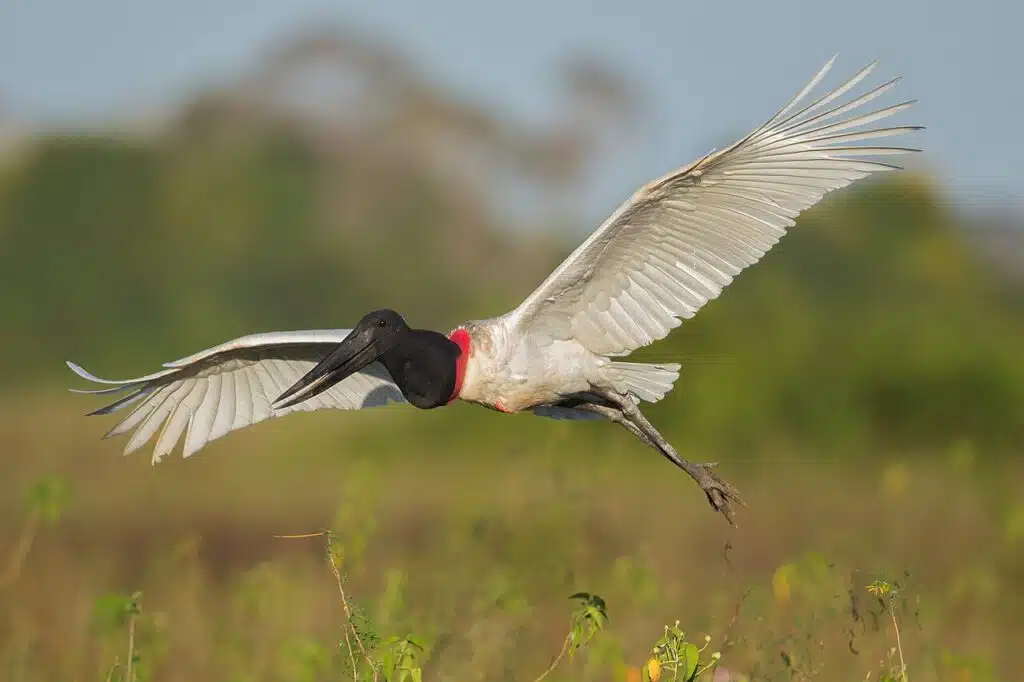
Jabiru storks (Jabiru mycteria) are mostly white. A white back and white wings are specific to these birds, together with a white underbelly.
Storks of this species have a black head and a black neck. Contrasting red throats are also seen on these birds.
South American and Central American countries are the native habitats of this species.
Living next to water sources such as rivers, lakes, and ponds, Jabirus feed on fish, snails, and frogs.
These birds are large, growing to a size of over 50 inches with males being a few inches larger than females.
Building nests on trees, these birds have stable populations across South America. They are never seen in large flocks as other storks.
Distribution – Brazil, Paraguay, Bolivia, Ecuador, Venezuela, Panama
Migratory – No